Peace Child Narrative History – 1982 to 1994
– An American Success Story –
by
David Woollcombe
After the Royal Albert Hall show, I went back to my job with TransAtlantic Films in Holland Park. That was it, I felt. Job done. But David Gordon, Eirwen Harbottle and my wife kept talking about what to do next? David introduced me to a couple of friends of his, Peter Jacobs and Johnny Toogood – who agreed to buy me a ticket to the USA to explore doing it over there.
The Kennedy Center Show
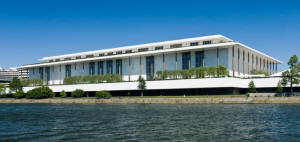
Kennedy Center for the Performing Arts
I went over for a week in November 1981 – chiefly to see James Grant, the legendary director of UNICEF. But he cancelled our meeting at the last minute, apparently because one of his sponsoring governments did not think that it was UNICEF’s business to work for Peace! Instead, I had fruitful meetings with the World Federalists and various Peace activists – but it was Gerry Jampolsky‘s introduction to Molly Whitehouse, a supporter of his Centre for Attitudinal Healing who gave the most support. It was she who booked the Kennedy Center for Peace Child on 3rd December 1982 before we’d remotely figured out a way of doing it.
I had made a second trip in June ’82 – when I had had the good fortune to meet John Marks, founder of Search for Common Ground – which at that time was called the Nuclear Network. It had a small office in the Dupont Circle Building – and I met John by chance at a party Gerry Jampolsky had sent me to. It was hosted by Marty Dutcher – a teacher and child specialist who lived on Macomb Street. Marty was involved with Werner Erhardt’s EST trainings – and it was EST graduates, like John Marks, who were the initial driving force behind the Peace Child show. And all they had to work with was the first Peace Child video.
John and I had a $7.00 chinese meal at the Nanjing restaurant off Dupont Circle where we struck a $100,000 deal. Rosey and I would produce the show at the Kennedy Center; he and the Nuclear Network would fill the hall. He would raise the $100,000 budget for the show from selling tickets; I’d work the other side of the footlights and create a great show.

Rosey and I + 19-month old Alexander came to the USA in July 1982 ( – planning to stay for 5 months but we ended up staying for 7 years.) I think it was Molly who introduced us to Mike Malone, one of the co-founders and directors of the Duke Ellington School of the Performing Arts – which operated in a big old building in upper Georgetown.
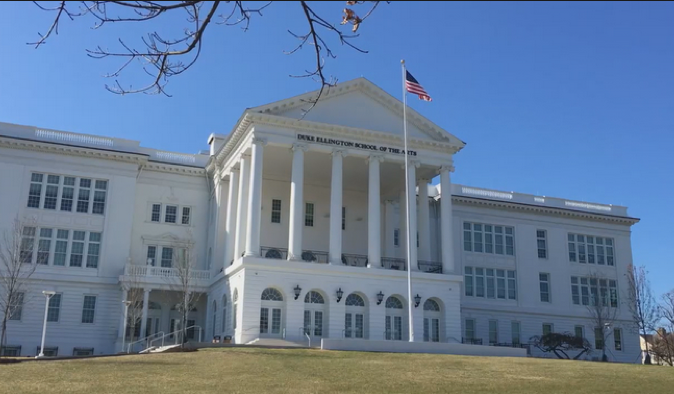
I have no idea how we persuaded Mike to choreograph the show – but we did. And he persuaded Mark Eldridge, the Principal, to give us access to Ellington’s brilliantly talented dance students. He also introduced us to Tony Booker – a wonderful musician and choral trainer / arranger. He got us the DC Chorale (director, Edward Jackson), the band and the orchestrator, Chris Royal. David Gordon recruited Jessy Dixon, and Rosey arranged auditions around the city to find children to perform the key roles.
We toyed with the idea of getting the Soviet Ambassador’s daughter, Yelyena Dobrynin to play the part of the Russian girl – but, though there was some interest from the Russian Embassy, such were the restrictions on Soviet children in Washington DC at that time, it was never going to work.
Instead, we had a series of auditions with very talented children across the Washington area – and came up with an obvious choice for the Russian girl, Bridget Condon from Rockville, Maryland – and a hard choice for the Boy between Marco Clarke, an African American boy from 14th Street, and Andy Green, a white boy from Columbia, Maryland. We went with Marco – with the result that, though the story was about Russians and Americans coming together, visually – for a Washington DC audience just a decade after the riots that convulsed the city following Martin Luther King’s assassination – the play was all about healing the racial rifts across the city.

Susannah York had enjoyed the Royal Albert Hall experience so much, she returned with her two children, Orlando and Sasha, to reprise the Story-teller role. Two fine actors from the Washington Arena Stage, Stanley Anderson and Alan North, took on the roles of the US and Soviet Presidents. The lighting was managed by Jeff Grandel from Gallaudet University for the deaf – which was interesting as, though they couldn’t hear what was going on, Jeff and his students were meticulous about every lighting effect so the show looked brilliant.
Mike and his team rehearsed endlessly at the Ellington school – where Rosey and I rehearsed the Core Cast and the Story-teller’s group. Interesting were the opinions of the US youngsters that were different from the UK young people: in the UK show, we had not identified the USSR and USA. It was an East-West conflict – but the US kids were having none of this: it was all about Russians and Americans. And – in a country convulsed by the Nuclear Freeze movement with thousands of Russian missiles targeted right on Washington DC, there was considerably greater passion about the need to eliminate nuclear weapons. The only real problem was the care-taking staff – many hours were wasted sitting on the steps of the Ellington School entrance waiting for some one to turn up with the the key! That – and the fact that we kept having to move house as one house-sit after another came to an end. But Rosey and I were very happy, buoyed up by our own, beautiful Peace Child, by the welcome we felt from everyone in Washington, and the presence of the wonderful Tessa Marsh, who looked after Alexander brilliantly during rehearsals, nursing her thermos flask – which was filled with gin and tonic, rather than coffee!
Start-up funding was always going to be a nightmare – and, in this, we were rescued by an incredibly generous loan from Josie and Bill Jordan. Their loan was all the more generous by the fact that they had just adopted an Indian baby, Josha: essentially, they agreed to adopt two Peace Children at the same time – and nurture both of them. That Josha is now a very successful young man, and that Peace Child Intl. is still with us – proves what good parents they were to both of us.

But it was John Marks and the Nuclear Network staff who really made it work. John was indefatigable, organising presentations in people’s homes, selling the $25 tickets to this unknown show, one by one, family by family. The “EST-ies” helped with their evangelical belief in the power of individuals to change themselves and the world. John filled the hall by telling a story of how the nuclear situation was like two people standing up to their knees in gasoline, each holding a box of matches, each daring the other to strike first.
The danger was very great – and young people were genuinely scared. A Boston professor, Robert Jay Lifton, was peddling the concept of ‘Psychic Numbing’ – suggesting that people were in denial about the threat. There were movies about Nuclear Winter, and the Pentagon was promoting the strategy of ‘Mutual Assured Destruction’ (MAD) – which, they argued, was the ultimate deterrent that had prevented a 3rd World War. So the appetite for Peace was very great – and Peace Child was lucky to be ahead of the curve.
The day of the show approached – and disaster: Susannah York got terrible tooth-ache and had to go to New York to visit her dentist. She missed the Dress Rehearsal – which was just as well, as it was the most disastrous cacophony of mis-haps and snafus it was possible to imagine. But the show itself went off almost without a hitch: Jessy Dixon’s microphone popped loudly on the first number, but after that – the show flowed like clock-work.
No one put a foot wrong. As one stage-hand said to me at the end: “The difference between the show tonight and that Dress Rehearsal this afternoon is the best possible reason for believing in God that I have ever seen…!” It was a miracle! – Marco was a revelation – the singing was inspirational.
The dancing was spectacular! As Peggy Cooper Cafritz, Mike’s co-founder of the Ellington School, said: “This is some of Mike’s best work ever…” A professor of Theatre Arts at Washington’s Catholic University, brought in to advise where to go next with the show, told us: “Don’t change a thing! Just carry on doing what you’re doing.”
Right wing Republicans weren’t happy with kids telling us to make peace with Russia: Rep. Stan Parris put down a motion in the House of Representatives criticising the newly formed Peace Child Foundation, and the Washington Times wrote a scathing review, saying that “Out of the mouths of babes and sucklings comes complete drivel some times….”
But veteran peace activist, Cora Weiss, saw it – and vowed to bring it to the Riverside Church in New York where she was sure she could persuade her friend, the Pastor there, William Sloan Coffin, to stage it. Also – very helpfully – National Public Radio did a lengthy piece with the kids on their ever-popular All Things Considered news show. That went out nationwide and generated a ton of interest from schools and community groups wanting to do the show. All that effort, and money, from the good people of Washington DC – led by the Ellington School and the Nuclear Network, paved the way for the next stage in PCI’s evolution.
Read More: Kennedy Center Archive – Playbill, Flyers, Press & Photos
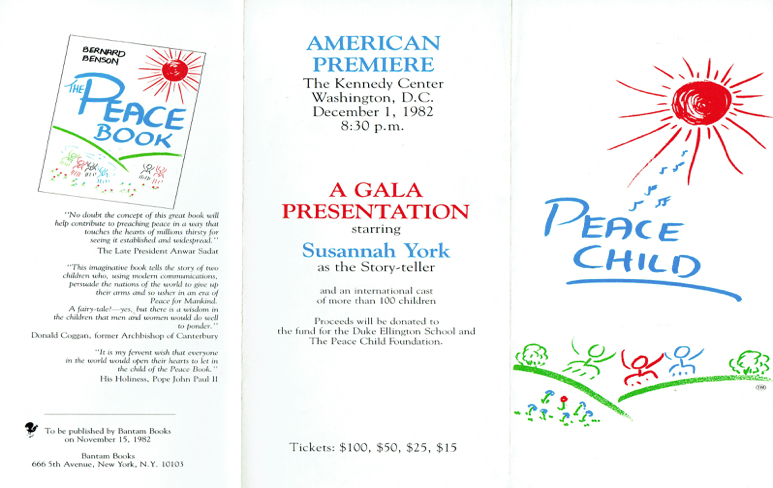
The Riverside Church Show:
The journey to the Riverside Church in New York was one of the more traumatic memories in the Peace Child story. Two friends of Tessa’s had joined us for the Kennedy Show having driven across America in a classic AMC Ambassador car – which Rosey immediately christened the “Yuck Car.” It was big and very ugly, but I loved it and had driven it to New York to finalise the details of the production with Cora, rent a flat, find a school for Alexander, and generally get things set up. I then drove back down to Washington to pick up Rosey, Alexander and all our clobber to drive them back up to New York.
It was a glorious, clear, moonlit night when I arrived at our home in Takoma Park. But – when we woke up the next morning – the world looked like this:

About two foot of snow had fallen over night – and I couldn’t get the yuck car out of our road: it just slid back down the hill. So – we set off for the Metro with our 19 bags and suitcases, carrying them in shifts down the street, Alexander in considerable comfort riding his police car. We got to Union Station and found the trains in chaos: we would have given up, but Cora had invited us to a party at Harry Belafonte’s apartment to launch the show, so I felt a duty to get there. We got the last train to New York – and stood in the corridor on a 6-hour journey to New York – only to find the same snow had fallen there and the city was in complete paralysis. It was Rosey’s first time in New York – and the Subway seemed to her like something out of a mediaeval vision of Hades: bravely, she agreed to go on ahead with Alexander to the house we were staying in in Brooklyn, while I found a taxi brave enough to take all our stuff up to our Flat on the Upper West Side. “You need U-haul!” said the taxi driver surveying our 19 bags. We did – but in that snow, it wouldn’t have been much good to us.
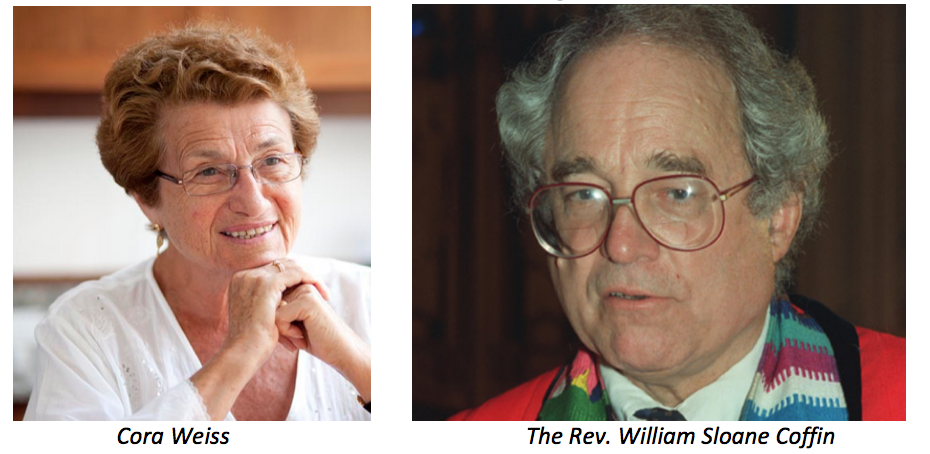
It was great to be around legendary peace activists like Cora and Bill – especially when Reagan and Oliver North were revealed to be complicit in the Contra-gate scandal. Bill Coffin’s excoriating rebukes delivered to the Reagan administration were inspiring – and that passion found its way into the Peace Child show. The Harry Belafonte party was a bit of a blur: we were so exhausted by our journey the day before. But we met some great people – and set to work the following day with a round of auditions in New York City Schools, getting a small but talented cast together. Marco was to come up from Washington to reprise his role as the Boy – but we found a new girl, Alison, to play the Russian girl.
It was great to be at the glorious mock gothic Riverside Church – which sits so majestically over-looking the Hudson River.
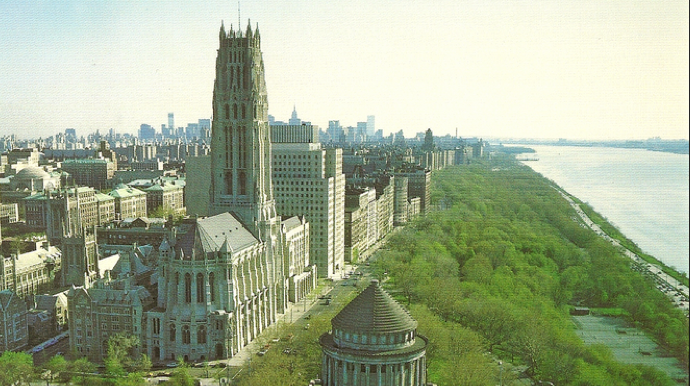
The Church has a resident theatre company – and a theatre in the basement. They didn’t have anything to do with us as we were performing in the main body of the Church – along with a specially built stage and sound system. Built in the 1930s, it is an extraordinary mix of ancient and modern – with stone stairs and windows, and modern phones throughout. I saw Bill taking a call in the Chancel – and asked if he had a hotline to the Almighty? “Sure,” he said, “And from here it’s a local call…!”
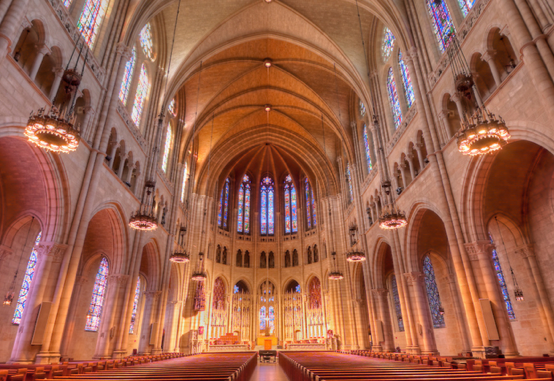
It was a tricky show to produce – with Marco only being available at week-ends for the Rehearsals. Also, New York was an exhausting place to be – and the children were a whole lot more materialistic, and less idealistic than the Washington DC cast. They kept talking about which car they were going to drive – and how they were going to get rich on Wall Street – all topics that interested them more than the threat of nuclear war.

But Cora, through Robert Benton, had persuaded Oscar-winning actress, Jane Alexander to be the Story-teller for this performance. She brought a grace and beauty to the show which inspired all who attended. “This must go around the world,” she told us: and years later, when a friend told her that Peace Child was working on sustainability issues, she said: “Oh good! That means that, like the Cold War, the children will sort it out.” Her presence also ensured that the show was a sell-out. Many church staff still remember it.
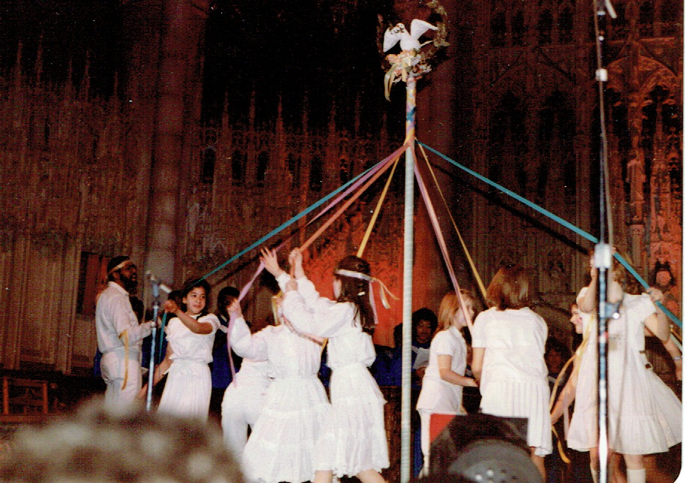
The Maypole Dance – Peace Day at the Riverside Church
Though the new Peace Child Foundation in Washington was intent on doing more productions – and we had “Tour Dates” for shows in York, Pennsylvania, Princeton New Jersey, and a network of DC schools, there was a clear demand for the script and music across the USA. So – on coming back to Washington DC after the New York show, to the McIlvaine’s lovely home off McArthur Blvd, ( – so lucky that they were always off sailing!) I started work on what would become the Peace Child Study Guide for Schools. This was the flyer that promoted it, and Peace Child, in the 1980s:1983 promo flyer
The Peace Child Study Guide for Schools
The Peace Child Music Score
Then check out the History of Peace Child as it happened through the 27 Peace Child’s Progress Newsletters we produced from the Fall of 1983 through to December 2000. Because, in the days before the Internet, Peace Child had to promote and send out copies of this all around the country. And – as you will read – hundreds, eventually thousands, of schools and communities took up the challenge to produce the musical.
Back in the UK, David Gordon, Bernard Benson and the Harbottles – the four other Peace Child founders, were not about to allow the USA to make all the running. So – they arranged for a Christmas performance of Peace Child in Southwark Cathedral which got some notice in the media.
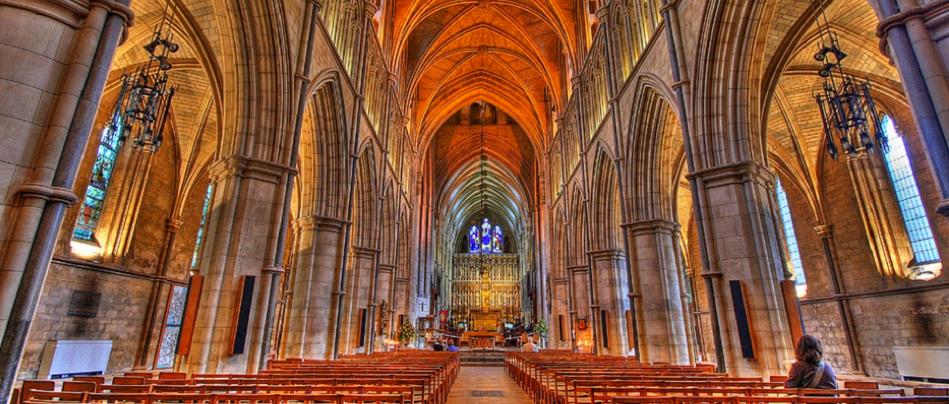
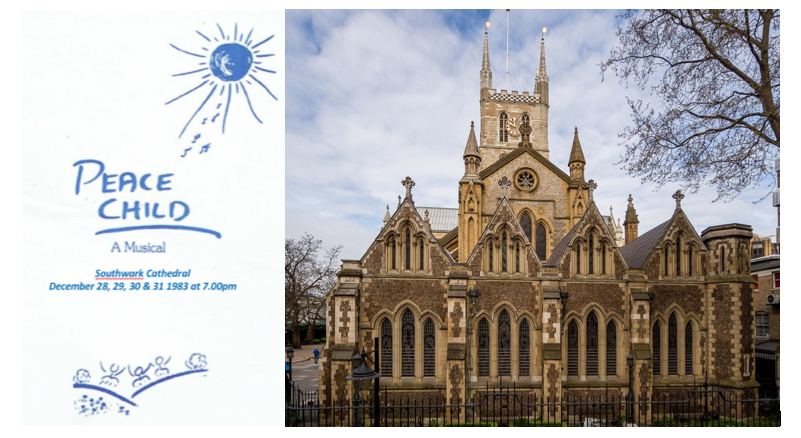
A colleague in the Peace Movement, Chris Senie from Connecticut, told me that he thought “Making peace should not be too easy…” He proved the point by cycling from Moscow to New York with a bunch of friends (Flying the Atlantic bit, of course!) The point is: doing Peace Child was NOT easy. You had to assemble a cast, put together a band, choreograph and rehearse dances and – most important – re-write the script and learn the lines. Then you had to stand on stage ( – really scary for some!) – and recite those lines to an audience of your parents and peers. Much easier to write an essay, or paint a picture in an art class. But much, much more impactive – which is why so many people who did Peace Child when young still remember the experience years later.
The Washington DC Schools Tour:
“Peace Child is a process, not just a performance,” said Lucia Effros – who became our Administrator, and massive friend and supporter of Peace Child – in 1984. Her husband, Steve, gave us our first office in Fairfax. With her calm demeanor, and total commitment, Lucia kept us grounded and focused – and made sure that we had a Board of Directors who met regularly and supported us.
However, we wanted to demonstrate that there were simpler ways of producing the Peace Child show. So – in the Spring of 1984, we produced the DC Schools Tour, performing a 60-minute version of the show with a cast of 10 – 8 x professionals, two children. We then took that show on the Road – to York, Pennsylvania and Princeton – with a rotating cast of children, including Garth Kravits (from the original Kennedy Center show) and Caitlin Siegel.
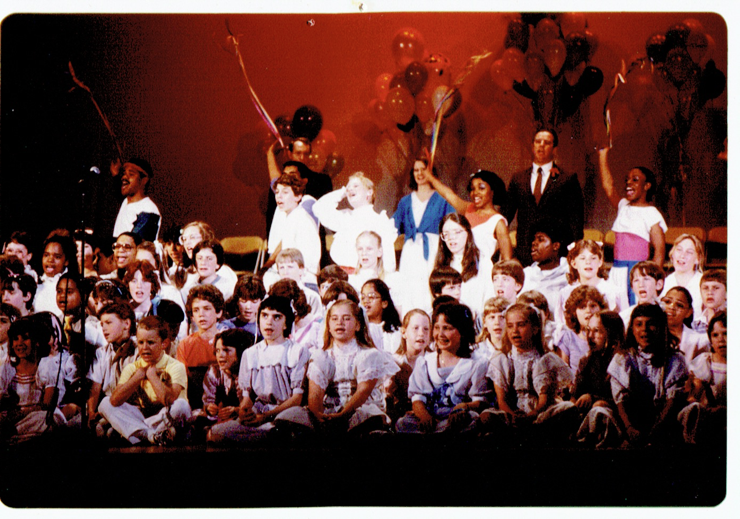
Finale with the York Pennsylvania Chorus
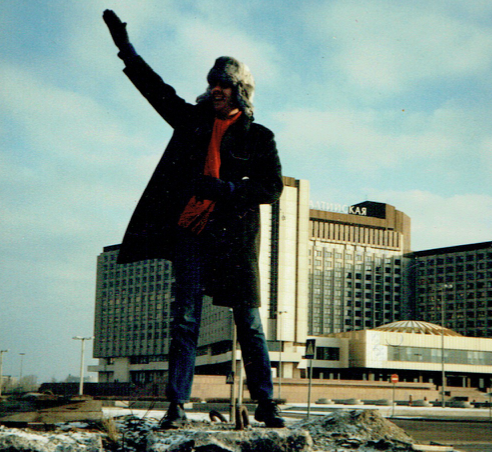
First tentative steps into the USSR:
It is almost impossible to remember how distant and mysterious the ‘USSR’ seemed to us back in the 1980s. There hadn’t been a summit meeting of US and Soviet leaders for about 20 years; phone calls had to be booked a week in advance, and were notoriously unreliable; Russians almost never travelled to the west, and only a handful of Americans ever went to the USSR. And yet, as Peace Child began to take root in the USA, Eisenhower’s old dictum about ‘people-to-people’ diplomacy was re-emerging as ‘citizen diplomacy.’ And many professional people – doctors, eye surgeons, vets, dancers and artists, business people and – particularly – young people realised the truth of the Peace Child message: it’s not the bombs that separate us. It’s whatever it is in our minds that make us think we are enemies. And that is costing us, big time! The famous author and astro-physicist, Carl Sagan, calculated that the Cold War had cost the USA $43 trillion dollars – more than the value of all the real estate, all the stuff and all the infrastructure in the USA. Any way to bring to an end this haemorrhaging of money and talent had to be worth pursuing. So there was considerable public support for Peace Child. Also, the USSR was still a “riddle, wrapped in mystery inside an enigma.” People were eager to see what it was actually like. Peace Child rode this wave, feeding on the interest that ‘meeting the enemy’ had for so many Americans.

The detailed History of Peace Child – as it happened – is recorded in the Peace Child’s Progress Newsletters produced at the time – like the above one recording my first trip to Moscow. In the days before the Internet, the Peace Child Foundation had to promote and send out copies of this all around the country. Here, I shall simply tell the story briefly, as I remember it, linking you to the records of various key, landmark productions. For the detailed history, consult the Newsletters!
I cannot remember even how many copies of the Study Guide we sold – but it was hundreds. Our office was busy sending them out most of the time. At $30 a package, it was a nice little earner. And every production was a triumph in its own way. For – as a colleague in the Peace Movement, Chris Senie from Connecticut, told me: “Making peace should not be too easy…” (He proved his point by cycling from Moscow to New York with a bunch of friends – flying the Atlantic bit, of course!) The point is: doing Peace Child was NOT easy. You had to assemble a cast, put together a band, choreograph and rehearse dances and – most important – re-write the script and learn the lines. Then you had to stand on stage ( – really scary for some!) – and recite those lines to an audience of your parents and peers. Much easier to write an essay, or paint a picture in an art class. But much, much more impactive – which is why so many people who did Peace Child when young still remember the experience years later.
Early Shows – 1984/5: Danville, Virginia –
With the publication of the Study Guide, interest was emerging from school play producers across the USA. Places we’d never heard of emerged as ‘early adopters’ enthusiastically producing everything from whole shows with casts of hundreds, to one or two songs sung in Sunday Schools. One of my favourite early ones was done by a Catholic School in Southern Virginia. Sister Claire had already produced Godspell and Joseph and the Amazing Technicolour Dreamcoat – and didn’t really want to do another. But her children so enjoyed reading through Peace Child, and their pianist was so enthusiastic about the songs – they forced her to do it. And they pretty much got on and did it themselves – as she sat at the back of the hall and watched. That – of course! – is the perfect way to let Peace Child happen: letting the kids feel total ownership of the show, introducing their own crazy ideas: in this case, it was sparklers bursting balloons during Fireball, and a Chinese Boy, who couldn’t really hold a tune, reciting the words of Look at Life over the music. All very moving.
San Francisco Show – 1984:
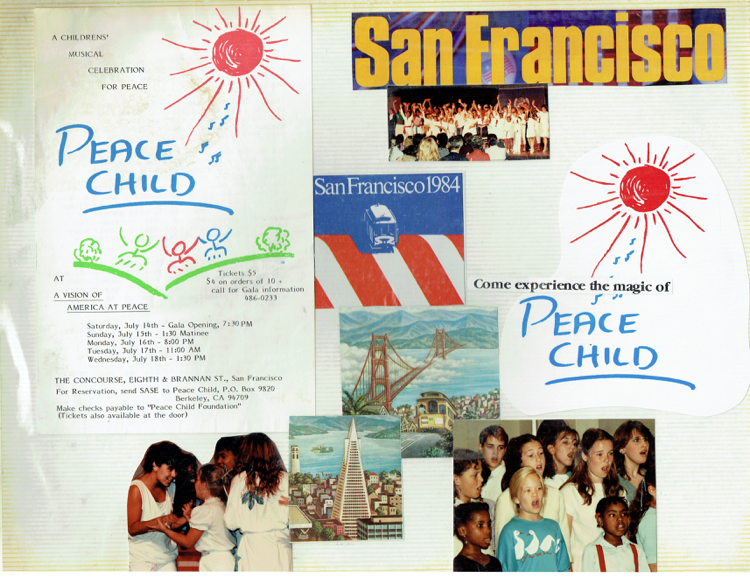
Following the DC tour, and the Princeton and York PA shows, we were invited to do a performance at the Democratic Convention in San Francisco. We got a connection in Princeton to Warren Buffet’s wife, Susie – who lent us her San Francisco “2nd Childhood flat” – artfully decorated in with Peanuts wallpaper and furniture. We had a contact at the Marin Country Day School, George Mineah – the music teacher whom we’d thought to use as MD. But when we met him, he urged us to use Steve Riffkin, as he was “younger, very talented, and with a strong background in musical theatre…” Steve became a legend!
I cannot recall how we got the invitation to perform at the Democratic Convention: perhaps it was through Senator Alan Cranston’s office – or one of our supporters in the Bay Area. At any event, it was a golden opportunity to spend the Summer of 1984 in San Francisco – and nurture contacts and relation-ships throughout Northern California which would reap massive dividends for PCF in the years to come.
Again, Rosey and I started doing the recruitment campaign – across the Bay Area. We had found a place to rehearse in Berkeley – so every one from Marin had to schlep across the Richmond Bridge to come to rehearsals. We quickly found two leads – Melissa Anderson as the girl, and Mark Mendonca as the boy. Melissa was a typical stage school kid: she’d just played Dorothy in Wizard of Oz. Mark was more rough and ready – but really got the environmental message. Melissa was bemused that there was no script when she arrived for first rehearsal. She was happy to sit and listen to the conversations about the issues with which every performance began. She was even OK to do a few improvisations – but not enthusiastic. She was basically waiting for some one to give her her lines so that she could learn them.
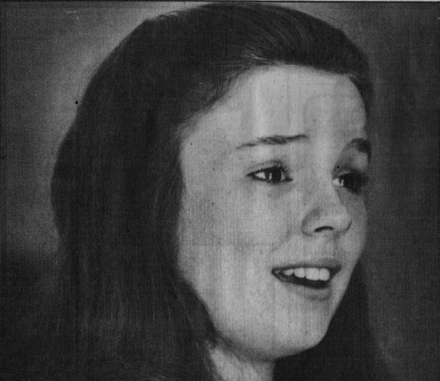
She was a very talented young actress / singer so – though I was frustrated by her attitude – I worked with her, trying to nurture in her an interest in all matters to do with Nuclear War and the Soviet Union: I asked her to imagine what a girl of her age might be thinking / doing in the USSR – and got her to read Jonathan Schell’s book, “The Nuclear Winter” – so that she could get her head around the issue we were discussing in the plan. She came back after a week-end of research on these issues – and she was a different person. Suddenly, she understood why we were doing this play: it was not just an opportunity to show-case her considerable talent. It was an opportunity to get Americans thinking about how we could end the Cold War. Poor Mark was gobsmacked when, in an improvisation they did that day, she laid into him like a harridan on speed: she had all the answers and, in a pretty convincing Russian accent, laid them on Mark – to the extent that he was silenced. She ended up being brilliant. She was the 1st Peace Child to go to the USSR, played the lead in both the ’85 and ’86 tours – and was arguably the most effective Peace Child cast member of all time.
Also in this show, we used Nina Galin to play our 1st female US President. This was appropriate as Geraldine Ferraro was the 1st female vice presidential candidate – and a Democrat! We had a small chorus – and we performed on the Arts Stage at the Democratic National Convention Trade Show. Alan Cranston and – to our delight – Carole King, dropped by to see the show, along with Dharaj Maxfield from the Theatre of All Possibilities in Santa Cruz – whose contribution to Peace Child would later prove tremendous.
See: San Francisco Album, – prepared by Zizi Mott, whose daughter played the Story-teller, this is one of the loveliest records of any of the US Peace Child shows.
Twin Cities Show, Minnesota – Fall 1984:
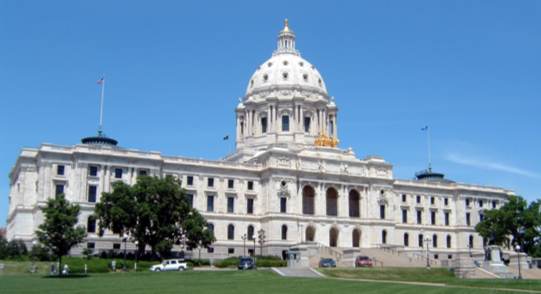
Again – I have no idea how we got the invitation to do the show at the Theater Arts School in the Twin Cities of Minneapolis / St Paul but it was a wonderful chance to sink roots in this most creative of cities – which became a keystone in future Peace Child projects. The Rev. Sally Hill of the Church Resource Center invited us, and arranged for us live in a basement in South Minneapolis. She also made the design of the Peace Child ‘football & duck’ logo which we have used ever since. We picked up the most crappy small Honda car with which we drove Alexander to his school each morning, and ourselves to rehearsals. Rosey was pregnant with Natasha during this production – so was taking things a bit easier. Happily, the school was very supportive.
It was a good-ish show – about which I have zero recollection. I do remember that Alexis Vaubel and Laurie Tucker were key cast members. Alex and her mother, Carole, became long-term PCI supporters – working on the ’85 Tour, the Space Bridge and the ’86 Tour. And we ended up donating our car to Laurie. Which is why, for years after, she would go round telling people: “Do Peace Child – get a car!” – but she failed to tell them that the car was an absolute death trap – with holes in the floor.
From Minnesota, we returned back to the UK, enrolled Alexander in the local primary school in South Hampstead, and waited for Natasha to be born.
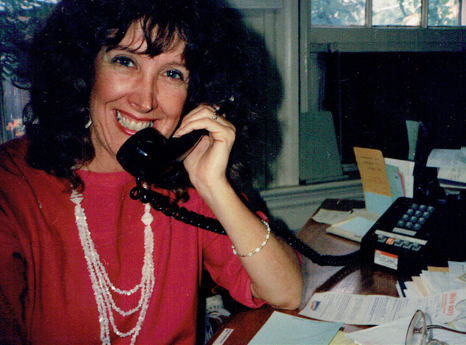
Meanwhile, Lucia was keeping the show on the road in the USA – supporting massive numbers of local shows, and assembling plans for Peace Child shows at two important festivals in 1985.
Peace Child, Santa Rosa, California:
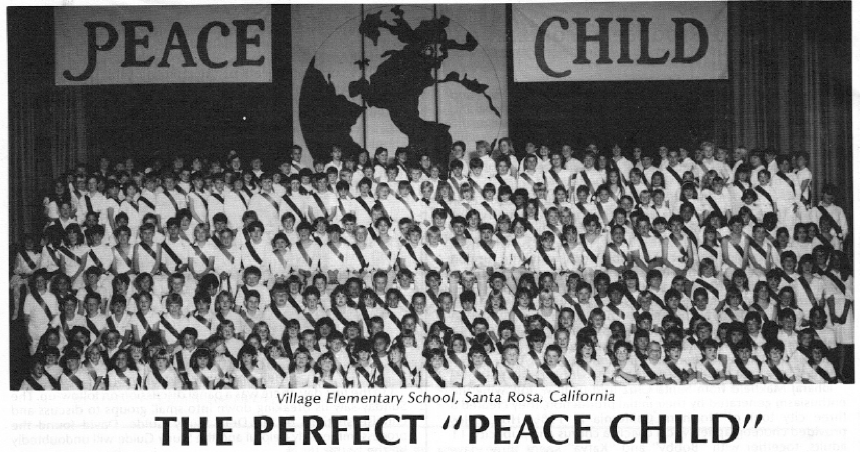
Initially, Tom Crawford, principal of the Village Elementary School in Santa Rosa, California, was not enthusiastic about doing Peace Child. He thought the name sounded sappy – and feared that some of the more right-wing parents in his Republican Northern California town would feel resistant. But – eventually, he capitulated to the persistence of teacher, Joanna Panas – and agreed to play the part of the US President. The entire school was involved – the staff, the children in the chorus, parents back stage – everyone. And the performances were magnificent, apparently, and changed the school for-ever: now when they need to deal with bullying, playground brawls, bad grades etc. – they use the conflict resolution tools they learned working through the Study Guide on Peace Child. And – by acknowledging his own stage fright before going on as the President, the Head-teacher found himself in a much closer, sympathetic relationship with his student body – and the rest of his staff. For that, and his courage in bringing Peace Child to Northern California, we dub this: “The Perfect Peace Child….”
It was not surprising that the children were the most enthusiastic supporters of Peace Child:

Look at the quotes above! Back then, it was much less common for teachers to ask children what they think – and, of course, when Peace Child did – the flood gates opened, and torrents of advice and opinions flowed into the play. Sometimes – this was overdone, as in a famous performance in Ojai, California – where most of the cast spent the 2nd Act in floods of tears and they shared and improvised their opinions on peace, and how to create it. But the children and producers felt it appropriate for their community – and that was the thing: children and producers could create productions that fulfilled their own, and their communities expectations.
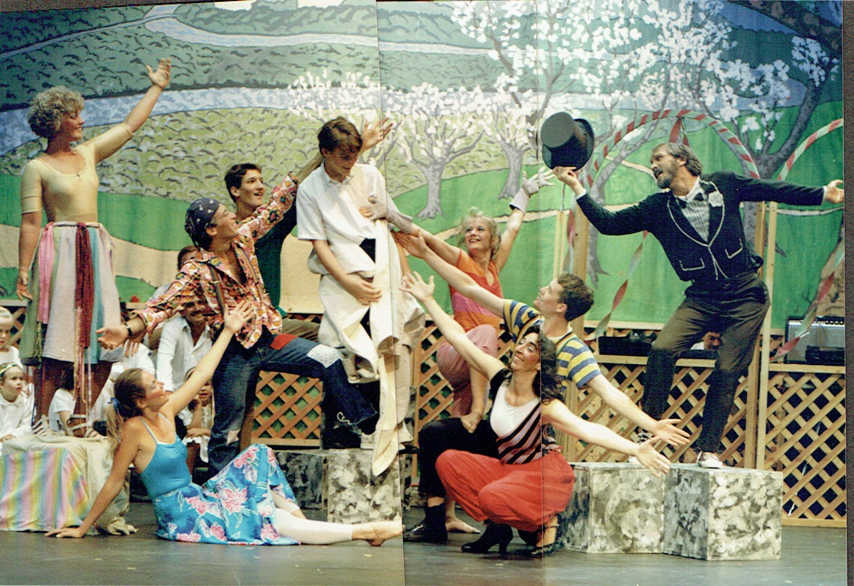
Theatre of All Possibilities – Peace Child Show – 1985 (Dharaj Maxfield with the Top Hat!)
Chapters emerge: –
We hadn’t seen this coming – but all of a sudden, Peace Child Chapters were emerging across the USA. Rochester, Santa Cruz, York Pennsylvania, TWO in Los Angeles!! It was amazing. And some – like the Theatre of All Possibilities in Santa Cruz were touring their shows, just as successfully as we were doing in Washington DC. Dharaj Maxfield had seen the show at the Democratic National Convention in San Francisco – and realised that his goals were precisely aligned with those of Peace Child. We were so fortunate that we had the talents of him – and of his great theatre company – to advance the Peace Child process and message up and down the West Coast. They also started a tradition – which was adopted by several other chapters – of celebrating the UN’s International Day of Peace.
An idea that was adopted by several other chapters and was developed by other organisations like Peace One Day and Pathways to Peace into fully-fledged movements. Of course, the original inspiration for Peace Day came from Bernard Benson’s Peace Book and David Gordon’s Peace Day song which opens every Peace Child musical. Other important chapters from which we have materials are the Minnesota one and the Toronto Chapter. If any other chapters have archive material that they would like to be archived on this website, please send it to me: david@peacechild.org
The Festival Shows – 1985: –
I had been commuting back and forth to Moscow since 1983 – establishing connections with the authorities, artists and theatre people – massively helped by citizen diplomats like Cynthia Lazaroff, Anya Kucharev, Vladimir Posner, Misha Shevelov, Stas Namin and others. Together, we had hatched a plot to bring US Peace Child over to do a show as part of the Moscow World Youth Festival – a deeply socialist event which tried to bring young people together from all over the world to persuade them that the Communist system was the greatest thing ever!
In order to balance the Soviet Communist tinge which would inevitably colour Peace Child’s image and brand in the USA, we agreed to take part in the Jamfest Festival of the Arts the US State Dept. was planning to host in Kingston, Jamaica:
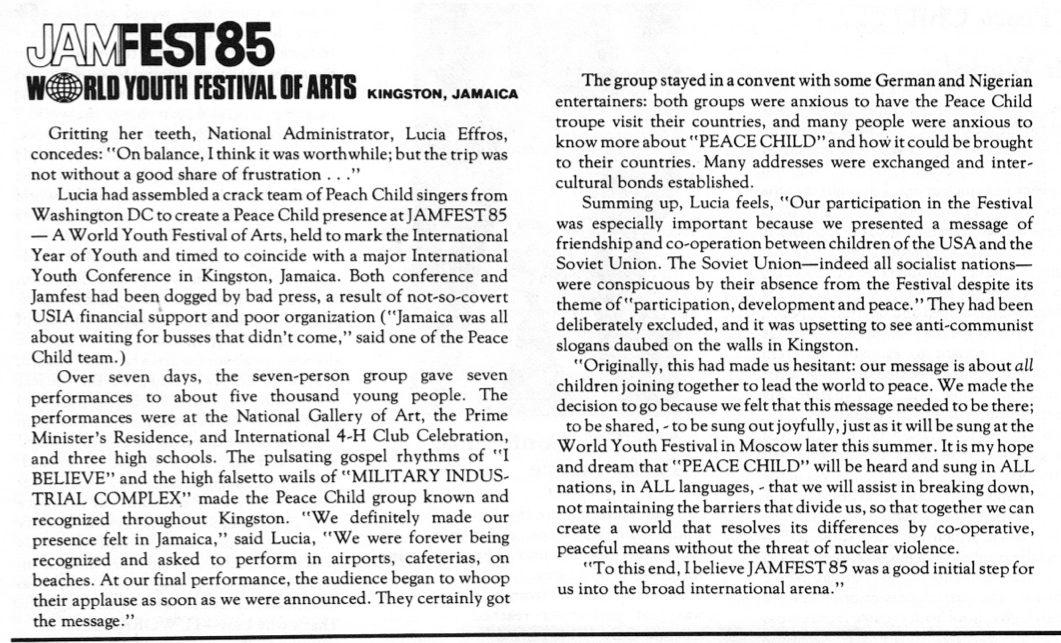
Both were propaganda exercises, but both would bring Peace Child to the world’s stage and, in the case of the USSR, fulfil the goal which – since our inception in 1981, we had dreamed of doing.
However, we had no intention of parroting their politics – just making an appeal for Peace. And they seemed ready to accommodate us – and even planned a tour for us to different stadia around Moscow, and to Artek in the Crimea. We rehearsed the Americans at a Field Centre across the street from the US President’s retreat at Camp David – an appropriate location, we thought, as it was close to where Jimmy Carter had agreed the Camp David accords. We then did a performance for DC Audiences at St Mark’s church on Capitol Hill – a copy of which is still in the possession of Sandi Croan, who was the chaperone for the trip, and whose two children, Tara and Adam, were the youngest members of the US Cast. See Here. (Video being prepared for uploading – watch this space)

When we got to Moscow, we incorporated the Russian children into the show – and Steve Riffkin and the Russian Band learned the songs – and introduced some new ones, particularly “Mwi Zhelayem Schastya Vam” (We wish you to be happy) – which the cast sang and recorded for Stas’s Festival Album – along with I have a Vision and Mr President. We ended up performing the show in front of legendary Russian poets, Yevgeny Yevtushenko and Andrei Vosnesensky at the famous Natalia Sats Children’s Theatre. Natalia welcomed us personally – and, when Gorbachev had his big Glasnost Assembly with Yoko Ono, Norman Mailer and the rest, she invited me to come as her guest as a pioneer of Children’s Theatre. This was an astonishing privilege from the lady to whom Prokoviev dedicated his masterpiece, Peter and the Wolf.
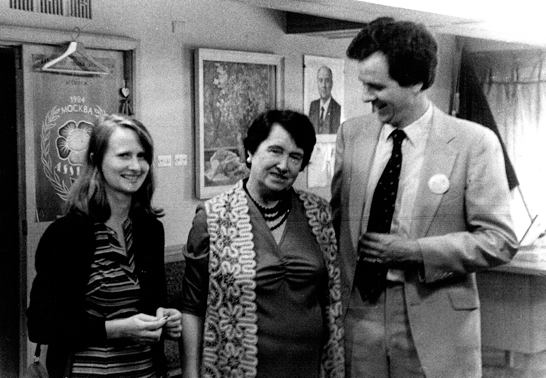
Rosey Woollcombe, Natalia Sats and David Woollcombe – with a picture of Lenin in the Background
As I wrote in the newsletter: “The most thrilling part for me was that is was all so normal. Though, in many ways, children and musicians from the USA and the USSR walking out on stage together was as unlikely as children walking on the moon together, when it came down to it – they all learned their lines, rehearsed their moves, sang their parts and had a great time together on and off the stage. And the Russians LOVED them. Even when Sasha and Gwen performed the lyrical “I have a Vision” at the end of a punk rock concert by the German band, the Scorpions, at the Olympic Stadium – and I feared that the punk rock fans would boo them off the stage, instead they stood and cheered for fully ten minutes. “I felt excited and honoured,” said Gwen Ross – the US soloist who almost had decided not to go on as she was deep in the throes of her pregnancy morning sickness.
It was while we were in Artek that we heard the dreadful news that Samantha Smith and her father had been killed in an Air crash. Samantha was a figurehead for Peace Child: she had written to Chairman Andropov, asking him why he was planning to blow her, and all her friends, off the face of the planet. Andropov replied, and took the precaution of copying his reply into ABC, NBC, CBS and all other media channels in the USA. There was a collective harrumph from the US establishment – which the Soviets gleefully exploited by inviting Samantha to the USSR and showing her a great time with other Soviet children in Moscow, St Petersburg and Artek. When she died so tragically, of course, the Soviets wanted to do a ‘Telemost’ – which is what the Russians had been doing to bring together women’s groups, business people and other sectors of society. This paved the way for the Landmark Peace Child / PBS Space Bridge of December 2nd 1985.
Royal Albert Hall Peace Day Concert – October 1985:
As though we didn’t have enough to do, we + the wonderful organising Team from the Ockendon Venture(below), took on the management of the UN Year of Peace Launch Event in the Albert Hall.
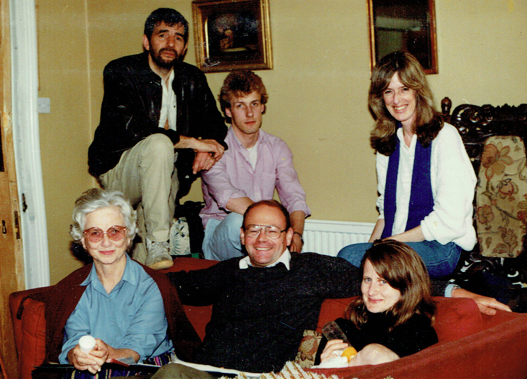
Eirwen Harbottle, David Gordon, Oliver Hall, Roger Daniel, Rosey Simonds & Diana Haydon
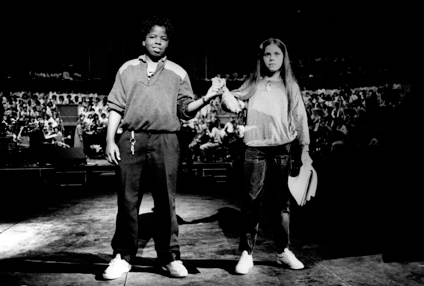
Calvin Samuel and Faruza Balk – star of Wizard of Oz
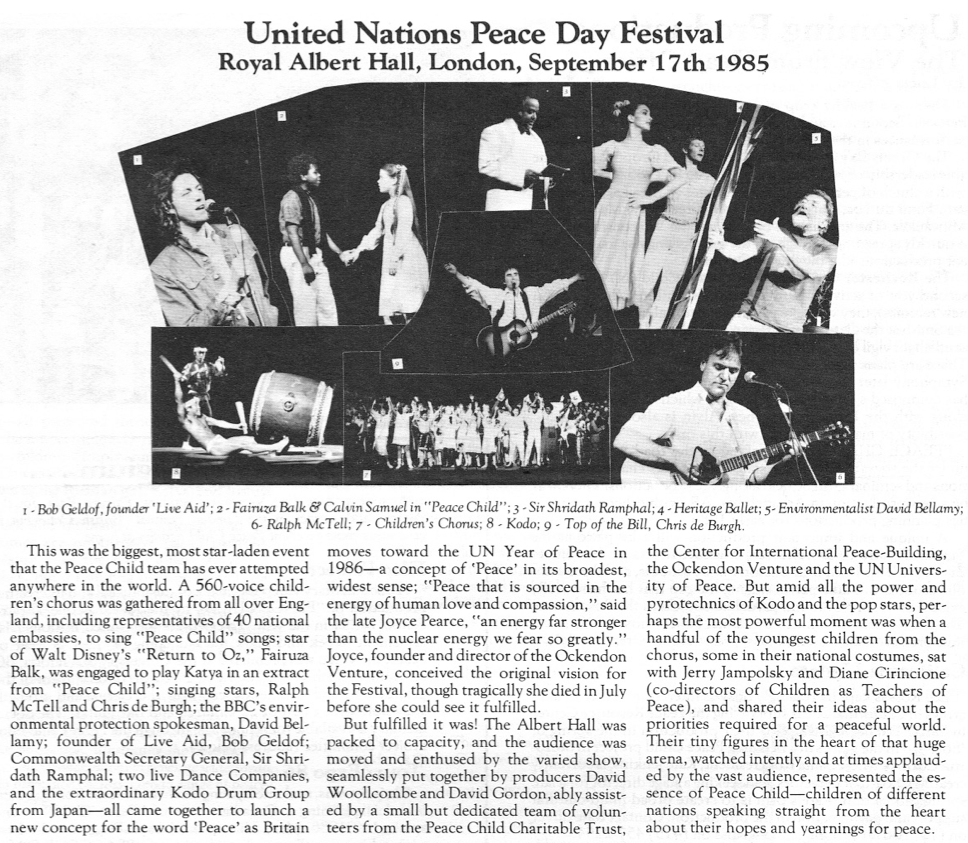
It was an extraordinary event – as the report above shows. The Kodo Drummers from Japan were electrifying, and Sonny Ramphal, S-G of the Commonwealth gave the speech of the evening, winning applause for practically every line he spoke. Sadly, the video made of the event appears to have vanished – but we have the programme. It paved the way for the even bigger challenges of the Moscow-Minneapolis Space Bridge and the breakthrough US-Soviet Tour coming up the following year. All three helped Peace Child win the UN’s prestigious Peace Messenger award the following year.
Soviet-American Space Bridge, December 1985:
With Natasha now 9-months old, we took the decision to return to the USA where we had been invited to do a production in beautiful Santa Barbara at the Lobero Theatre. Steve Rifkin, who had earned his spurs doing both the San Francisco show and the 1985 Soviet Festival show, agreed to MD. Before that, there was the small matter of the US-Soviet Space Bridge – for which we had signed a contract to do between WCCO-Minneapolis and Gosteleradio in Moscow. The deal had been brokered by the wonderful David Speer, of Padilla & Speer – Minneapolis’s premier PR Agency. Dear David, now sadly departed, shouldered the entire financial burden of producing the show and bringing to it the best PR and news coverage Peace Child had ever had. We did it at the famous Minneapolis Children’s Theatre linking to a studio in Moscow – and, under the skilful management of Kim Spencer and Evelyn Messenger, the link up was flawless – especially the moment when a Soviet and American child, linked on a blue-screen image, reached out, touched hands – and sang “Reach Out for a Star!”

But the most remarkable thing about it was the presence of John Denver. The American cast members had re-united at a farm some 100 miles north of the city. And – when it came to drive back the night before the show, it was snowing heavily. We worried that we were not going to make it back on the Freeway – and that our entire cast would freeze to death in a snow-drift! Much worse – how on earth was John Denver going to fly in from Aspen – with the Airports all closed to commercial traffic? Sure enough, in the morning, we had a message from Denver’s office saying that there were problems landing in Minneapolis – but that, as it was a crystal-clear morning, he was still hoping to fly in. And fly in he did – arriving on stage at the Children’s Theatre about 3-minutes before the link was due to go live. No time for rehearsal – Nothing. Just go for it – and, supreme professional that he was, he was word perfect – and wonderful. And, at the end, he sat amongst the American kids and chatted about his beliefs on camera. It was a deeply moving moment.
On Christmas Day 1985, the Space Bridge was broadcast nationwide on the PBS network – garnering an audience of millions. It didn’t raise the millions of dollars that we’d hoped – but everyone said that we were bad about asking for the funds. It was true – we were always lousy fund-raisers. But we kept working – and surviving, and affording the endless trips to Moscow.
Moscow-Minneapolis Children’s Space Bridge – Short-Form Video
Lobero, Santa Barbara – 1986:

Christmas 1985 – with our new baby girl, and our eerie up in Painted Cave on the hill above Santa Barbara, was gorgeous. The photographs show the staggeringly beautiful position, looking down over green hills to the Pacific. It was a magical place to be – but hard work: I had to commute to Moscow as we now had the possibility of a US-Soviet Tour and to bring the first soviet youth and rock band to the USA on a Youth Exchange. Laurie Tucker had issued the invitation on the Space Bridge and, though the Soviets had cut the invitation from their broadcast – the fact that the show was repeated 7 times on Soviet Television, showed the Soviet authorities just what a fine propaganda tool they had in Peace Child. Still – the bureaucratic constraints to allowing Soviet children to tour a ‘decadent western musical’ to the USA remained formidable. It took the combined energies and creativity of Stas, myself, Vlad Posner and many others to figure out how we could do it.
The key was to find a sponsor who was not part of the government. An ideal one would be the International Trade Center: if they wanted to promote a Soviet-American peace musical to boost trade, there was, in theory, nothing that the government or communist party could do to stop them. Also – in the era of glasnost and perestroika which was convulsing the arthritic Soviet bureaucracy – something like the Peace Child exchange programme was the flavour of the month – supported at the highest levels. Even so – as you will read in the attached history – it was touch and go up to the last moment.
Meanwhile, the Lobero Theatre performance was cast and mounted – with considerable assistance from local troubadour, Chic Streetman. Chic’s wonderful Peace in the Heart song – a canon in 7 languages, became a staple of the Peace Child shows for ever after. It is a superb collective experience singing for peace in different languages all at the same time.
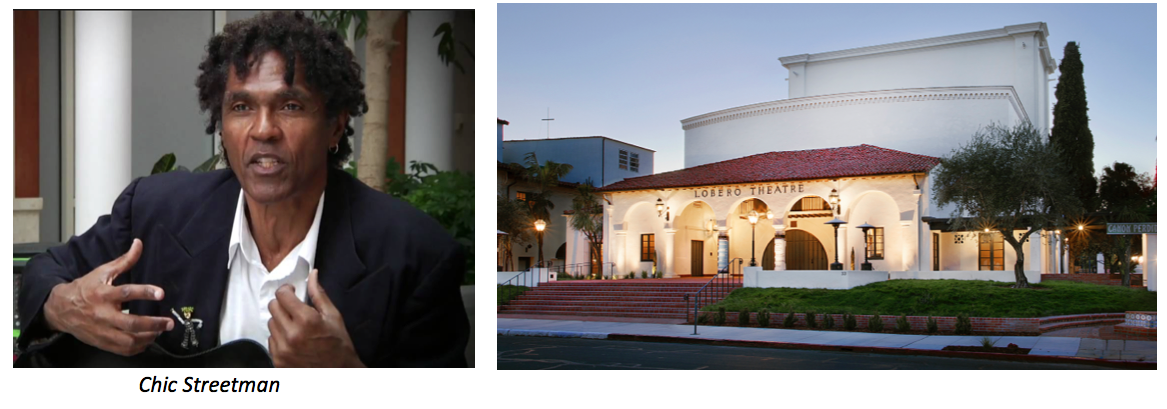
Steve Riffkin came down from San Francisco to direct the music, and two new friends from the Space Bridge, Barbara and Howard Katz, flew in for the show. Lobero Programme Rosey, balancing Natasha on her hip, produced the whole show from a wall phone in the Kitchen in Painted Cave – while I was away in Moscow much of the time. The person from whom we’d rented the house in Painted Cave came back just after we’d done the show and – as we hadn’t got anywhere else to go – we moved into a temporary home, first in the Trout Hatchery, then in Goleta close to where Alexander was going to school.
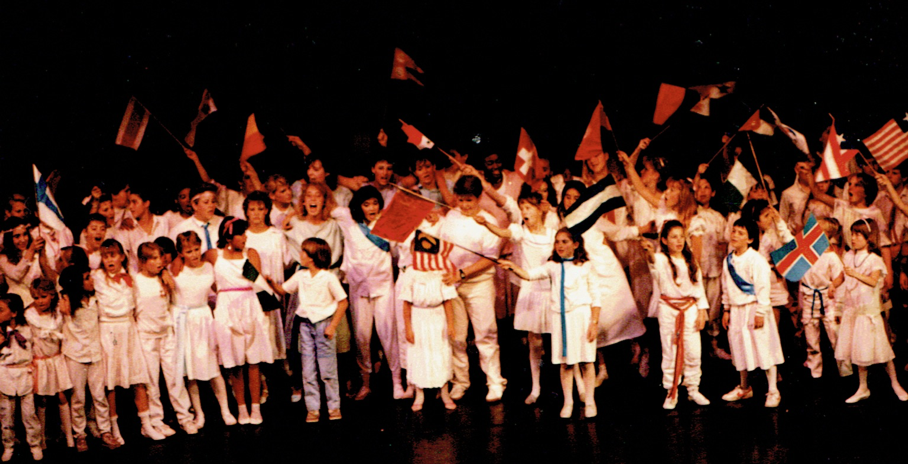
The Lobero Finale
As well as trying to produce the show in Santa Barbara, navigate the resistant authorities in Moscow, raise funds for the tour and keep our young family together, I was also working to jolly along the 12 x tour teams in the USA and Canada. We had a tour manager, Michael Lindeman, who scored an early success by raising $100,000 from Steve Wozniak – co-founder of Apple Computers. He helped enormously – but the faith of the hundreds of American men and women who supported the tour – while I was not at all sure that it would ever happen – was extraordinary!! We were used to being blessed with Miracles in Peace Child – but in planning the 1986 summer tour, we were stretching the powers of the Almighty perhaps a step too far!
OUR FINEST HOUR – Summer 1986:
The whole story of the 1986 breakthrough tour, written up from my diaries of the whole experience + the funding proposal, the press reports, some of the thousands of photographs that were taken during it, can be found here. The experience of the tour was distilled in this 13-minute documentary
which was shown, endlessly throughout the USA and Soviet Union to drum up support for the subsequent tours – about 100 of which were organised between 1987 and 1994.

The Archive and the Video will give you a sense of the joy and sense of achievement we all drew from the Tour – and what follows is just a brief impression of the story that convulsed our lives for ever after. It was the FIRST Soviet-American youth musical; it was the FIRST time a Soviet rock group had toured the USA. It was the FIRST US-Soviet reciprocal Youth Exchange – an effort that every one from the Scouts to the American Field Service had been trying to pull off for years; and it did set up the Peace Child Foundation as the world’s premiere youth / cultural exchange body dedicated to furthering people-to-people ties with the USSR. And – further – we had a political agenda: were dedicated to bringing down the Iron Curtain!
July 1986 found me in Moscow waiting for the US Cast to arrive and suffering from the frustrations of not being able to phone or e-mail any one in the USA. Even fax was challenging! And there were almost no computers in Moscow! So – everything was being typed up on my Mac Classic or portable typewriter! We had found a Russian cast, and the Americans were set to join them on the Friday night to co-create a show! The Soviet Ministry of Culture had gotten in on the act – not in itself a bad thing as they could, if they wished, smooth several of the government obstacles that would stand in our way. But – it rather gave the lie to our show being a ‘cultural promotion for the Trade Centre!’ The Minister of Culture was supposed to see the show on the Thursday – not giving us much time to write, rehearse, prepare in Russian, an entire 2-hour musical. And then North-west Airlines let us down – with not one but TWO broken planes! This meant that the US kids did not turn up until late on the Sunday night, dog-tired – and with just 3 and a half days to prepare the musical.
We had the rough plan for the show – but it needed a lot of fleshing out. And we had two directors – myself and Vladimir Alennikov, and a choreographer, Vlad Druzinin, who was not good under pressure.
And pressure did not come much greater than getting a 2-act musical up and running in 3 days. But the kids refused to see the problem: they dived right in and, supported by an amazing team of Steve Riffkin, Tony Booker, and Stas himself, they pulled together the bare bones of the show – ready for 14.00 on the Thursday, when – spot on time – the Soviet Culture minister turned up. Now my memory differs from the story that I wrote – because I am sure that the Minister’s heart was melted by the show – and that he came and embraced the kids immediately after it. Maybe he didn’t – maybe it was later when he was saying good-bye to them. But – we do know that he was impressed and that, following the audition show, the Ministry of Culture allowed us to continue with the tour – and travel to Ulyanovsk and Artek.
The tour itself is a blur in my memory: little snippets stand out. First – we all realised that we needed a better choreographer than the one we had – so we called up Mike Malone, the excellent choreographer of the original Kennedy Center show. And we got him a visa and a flight, but he couldn’t join us until Artek. So – he had to get a train from Moscow to Simferopol, and then a taxi to a bus-stop in Yalta – where I was supposed to meet him. And – being an African-American in the USSR was not a comfortable experience – and the lack of mobile phones or any way of reaching him easily was a nightmare. So when I came to the bus stop in a taxi at the appointed hour and found Mike, cowering in a door way, waiting for me – I was more relieved than I’d ever been that whole tour.

Mike Malone, Tony Booker and members of the Cast in Yalta, Crimea
Mike transformed the show – disciplining the whole cast, and tightening up the music and the dialogue. By the time we did our final show in Moscow, it was not half bad – and, heading out to the USA, we felt buoyant and confident we had a good show. The business of getting exit visas from the USSR, transit visas through the UK, and entry visas to the USA was a complete nightmare – and we didn’t know until the last minute who would get them. All that – and booking 21 flights for each person around the USA was a logistical horror story – but, somehow, it was all dealt with. And we got on the plane, travelled to London, had a great night out in London climbing on the lions in Trafalgar Square and arriving in York Pennsylvania, all set to conquer America.

York PA was just the best place to start a tour. The Russians loved it – a small town on the edge of the Amish country with lovely people like Bill Schintz, the local photographer to welcome them.. America starts in Pennyslvania – and nowhere was that more true than our experience in York. An abiding memory is of the Russians and Americans dancing wildly to “YMCA!” – and the po-faced Russian Ministry man doing the ‘Funky Chicken’ with a fluffy chicken on his head. Slava, one of the young Russian cast members was asked on a TV interview in California which his favourite city had been on the tour: “York,” he said. “Oh, you mean New York…” said the interviewer. “No – York Pennsylvania. That was the best city…” The interviewer had probably never heard of it – but for all of us, York PA is seared on our memories as a happy, happy place.
We had two or three days to re-write and rehearse the show in English – but that was easier as most of the Russians spoke pretty decent English. And Mike was working in his mother tongue – so he rose to the occasion brilliantly, tightening up the choreography – making numbers like Fireball and Reach Out sensational. And the Russian music was delightful – the Siberian folk songs sung by Sasha Malinin, and Eta Musica sung by the lovely story-teller, Ludmila Senchina, affirmed the beauty of the Russian Culture.
We have a recording of the whole show from the Wilton Theatre, Los Angeles. It is introduced by US talk show host, Casey Kasem, Stas and myself and, though just a single camera shoot – you will get a sense of the vibrancy of the music, and the passion of the young performers. They knew they were making history and it shows in their commitment. Also, it reflects a golden moment in Peace Child’s history. This was the first Soviet-American youth / cultural exchange – and it was not some dry, dusty seminar, or playful antics at a New England Summer camp, or some po-faced classical musicians playing a concert of music composed hundreds of years ago: this was young Russians and Americans having a great time together, singing and dancing their hearts out in a story that showed their commitment to a future of peace and co-operation. It’s only a little sad to reflect that now – 30 years on – the need for peace and co-operation is possibly even more necessary than it was then back in 1986.

Another tiny backdrop to the tour was that Rosey and I bought a house in Falls Church VA. We didn’t really have time for this – but it was important to have a home, so we pooled resources and made our commitment to staying in America by buying a house at 7326 Poplar Court, Falls Church, Virginia deep in the DC Suburbs, just inside the Beltway. Such was the pace of the life we were living, I’d viewed it, but Rosey had not: she collected the key and moved in without ever having seen it before!
I should just mention the blood I shed for this first Soviet-American Youth Exchange: one morning in the Trade Center Hotel, I was hurrying along an upper gallery to a meeting. The Atrium has a very elaborate clock with a cock that emerges to crow on the hour. That morning, I happened to be passing as it struck. I was transfixed seeing the mechanism in action for the first time – so I stopped looking where I was going and slammed into one of the lampstands on the balustrade. Blood poured from my forehead! Steve, who was with me, was concerned to call an ambulance – but I was determined to get to my meeting so, jamming a handkerchief to my forehead, I arrived, bloodied but unbowed, and carried on my effort to get the 1st Soviet-American Youth / Cultural exchange out of the starting gate.
Endorsements & Support Letters: We were encouraged that so many former Presidents, Senators, NGOs and individuals cheered us on from the side lines. You can read some of the letters here – and you’ll get a sense of how many Americans wanted Peace Child to succeed. Our children were carrying the hopes and dreams of millions of Americans – none more so than the children themselves.
1986 / 1987: Away from the excitement of the Soviet-American tours, Peace Child shows were being produced across the USA – in practically every state it seemed. Chapters were springing up, and Peace Child choirs singing David Gordon’s lovely songs were a feature of Peace Marches and religious gatherings almost everywhere. Two playbills give a sense of the kinds of productions that were typical:
Eltham, Massachusetts Show and Des Moines, Idaho. Both were started by schools wanting off with a show then, finding it so popular, they were able to take it around to communities and local chorales eager to sing along with the choruses to the songs about Peace and Love. A similar phenomenon started in Green Bay, Wisconsin Show – 1987 – but this one ran and ran, for months. They started doing three shows, then every month, they’d write to us telling us of other performances they’d given at schools, universities, churches and synagogues around the great state of Wisconsin! At last count, they had done about 50 shows. (If any one has information about this, or any other domestic US tour done in the 1980s, please send me – david@peacechild.org – information for this archive.)
Peace Child rode the wave of Gorbachev’s re-invention of the USSR as a place of openness and re-construction (‘glasnost & perestroika.’) It was, indeed, “Morning again in American-Soviet” relations. The Meeting in Reyjavik and the START nuclear agreements seemed to mirror the détente we were witnessing between the children on Peace Child stages – and between Peace Child and its American audiences. Peace Child became iconic for that generation of Americans.
Theatre of All Possibilities, Santa Cruz Show – 1987: Dharaj Maxfield followed up his West Coast tour in 1985 / 86 with a Northern California Soviet-American Tour – bringing Soviet kids to enjoy life and create a show in the Santa Cruz mountains above Silicon Valley. As he wrote in the Playbill for the Soviet American Tour: “The dream of Peace Child is happening – you will see it take place before you tonight. Children from “Enemy” nations are becoming friends, learning about each other, and cooperating on a creative venture to grasp for that elusive thing called ‘peace’ and seeking to make it a tangible experience in our lives. These peacemakers are becoming the new leaders of our world, growing up with the knowledge of their individual contribution and importance to the world as a whole.” Check out the playbill he forwarded to the Office.
East Coast Tour – 1988:
I have to say that, by 1988, I was getting a bit sick of the “Soviet-American” focus: the world was bigger than the two super-powers – and I was longing to introduce new characters, new nationalities into our stories. So – in setting up the East Coast tour, we actively recruited, along with Russian stalwarts from the ’86 tour, Ella Vituk and Slava, Japanese, Dutch, Polish, Belgian, Australian, Irish and Papua-New Guinean young people – who sang a song, DmBga, which we all came to love.
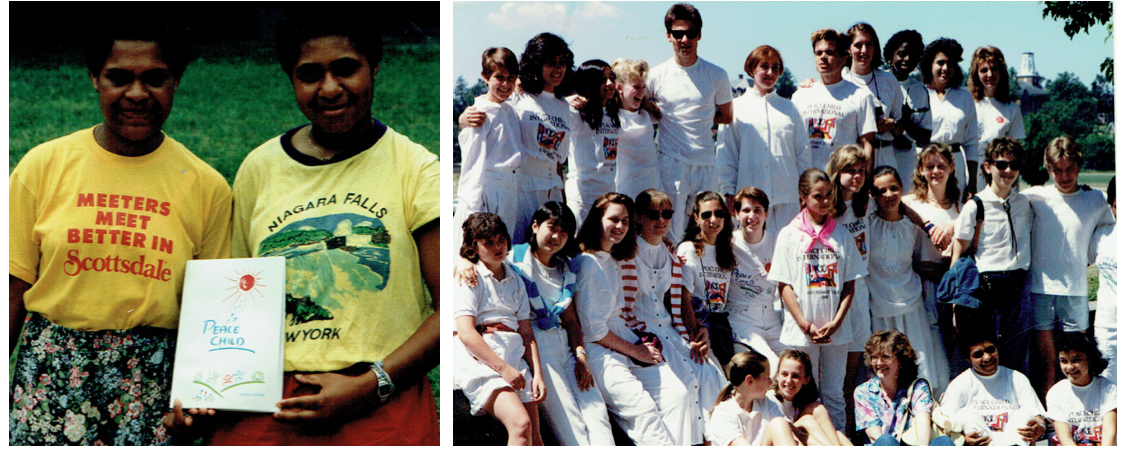
And we were richly rewarded: Miki, our Japanese cast member, organised 7 International shows in her home town of Hiroshima, mostly with Japanese students – but also with visitors from other countries. The Polish cast member, Pavel Sydor, rewarded us with one of the best songs ever contributed to Peace Child, the lovely “We want this world to survive for ever.” And – through Amber, the Dutch girl who played the lead, we found, in her father Ludo, a friend who has stayed with us ever since. And he was a major reason for us moving to The Netherlands a year later.
But the show was …. Interesting. We did it first in Harrisburg PA – because we had a place to rehearse there. And it really, really did NOT work. I was scrawling all over my note pad on the first night, “THIS is SHIIIITTTTEE!!!!” – and it really was. A horrible, horrible show – that didn’t work on so many levels. After the show, Steve and I – and some key cast members, sat round looking at each other. This had never happened before: a show that really did not hang together. Drastic surgery was needed – and we agreed to meet the cast the next morning for the notes – and the cuts, and the re-writes, and the re-ordering. It was brutal – but everyone knew that it had to be done. David Gordon never agreed with the dictum that “Peace Child is more a process than a performance…” – and, in Harrisburg, he couldn’t have been more right: if the process leads to a terrible performance, dump the process. The cast agreed – and so we started shaping the new show. In fact – it didn’t take much: to Steve and I, it was clear where things were going wrong. So we sorted them out – laid them on the cast, and in 48-hours, a brand new show emerged.

The next stop was Gettysburg – where we were scheduled to join a centenary celebration of the famous Civil War battle. First we had to do the show – and Ludo, Amber’s father, was there – beaming in the audience. He’d come all the way from Amsterdam to see his daughter – and, if she was as bad as she had been that first night in Harrisburg, he would never speak to me again.
But it wasn’t! The Peace Child magic worked again – and the show was as good in Gettysburg as it had been bad in Harrisburg. Amazing what you can do with wonderfully flexible kids, and brutally firm directors cutting the crap bits. It was really a wonderful show – and it played well in Pittsburgh, Chautauqua, Baltimore and all the other towns and cities we took it to. And the March for the centenary of Gettysburg was wonderful too – with the only slight embarrassment that the best voice we had to sing the US National Anthem was a Canadian. But she looked lovely – and Carl Sagan, also on the platform, congratulated her warmly. Dear Ann Cummings: her mother was to lead the Toronto-Volgograd show – but her presence in that magnificently talented cast enriched us hugely.
I loved this show – for several reasons. First it came back from the dead; second, the MD, Craig Lindvahl – played all the music on an Apple computer; third – we had actual Papua New Guineans acting out the story of the central Peace Child myth. And Fourth because we had the amazingly talented Pavel – who not only composed one of Peace Child’s best songs. He also sat down and played the 2nd Movement of Beethoven’s 3rd Piano Concerto in the interval of one show. He was that kind of talent.
And the cast formed such close bonds: there were tears and fears about separating from each other even when we got to Chautauqua – and there were three more shows to go after that. But the hugs and the weeping was all part of the closeness we felt for and with each other. Brilliant! East Coast Tour

Central America Show:
We did one of the loveliest Peace Child shows ever at the Sidwell Friends theatre: it was our first show about something totally other than the US-Soviet relationship. It centred on the civil wars of Central America – and was about some Americans who went there on a work camp, and about a relationship that developed between a young American girl and a Central American soldier – who got killed. It was lovely doing it around the corner from where we lived with the wonderful Lib Segal – a quaker who’d supported Peace Child since the first Kennedy Center show. She welcomed many of the cast into her home – including the wonderful Melissa Anderson and Jamie Lopez from the ’86 tour, Steve Riffkin and his friend, Jimmy Reitzel – who did some of the most lovely guitar accompaniments for the Peace Child songs. Beautiful! And Rachel Riddle narrated the Video about it. One of the best things was a young Nicaraguan who had never seen snow before: her father was an American – and he was very knowledgeable about the politics of Central America – and helped a lot with the development of the script.

This is surely one of the weirdest photos in the entire Peace Child History – Daniel Ortega, the revolutionary leader of Nicaragua and film star, Kris Kristofferson with long-time Peace Child supporter and Trustee, Neil Biddle. She had long wanted to go and find out what was happening in Central America. So – as preparation for our Tour, I went with her. And somehow – we got to have lunch with the great revolutionary! I don’t remember much about the meal except that, Castro-like, Ortega talked non-stop for about 4 hours as the translators struggled to interpret his ramblings to Kris, Neil and me! But it was a fascinating insight into the revolutionary fervour, and anti-American / Anti-capitalism that drove so much of the politics of Central America.
I had had such a good time developing this show and learned so much about the history and politics of the region, I really didn’t want any one else to direct the first Central American tour. Dharaj Maxfield was set to direct it – and he might have done a better job. But – having done so much work on the DC-based pilot show, I really didn’t want to give it all away. Big mistake, given the enormous hassles, visa problems, nightmare of doing it first in Spanish, then in English… It was a nightmare I could probably have done without, especially after the stress of the East Coast tour.
But – the family, Rosey, Alexander and Natasha were all quite keen to go to Costa Rica, so we set out en famille on what was to be a tour of mixed blessings. Far from being a tropical paradise, it rained almost every day we were in Costa Rica. We stayed up in the mountains outside San José in a hostel type of place with very limited washing facillities. The Costa Rican co-director was not an easy person to work with. I fear I am not either – but the relationship was never positive, and thus difficulties and disagreements became fairly insuperable. She complained about the International Cast’s ‘bad Spanish’ – hardly surprising given that none of them were fluent Spanish speakers. For me, it became a question of getting through the days, getting the production over with – and trying to transform it into a half-decent English Language show by the time we got to San Francisco.
The best thing about the show were the new songs composed by Walter Flores Mora, a friend of the musical director, Amelia Barquera. “Somos Futuro” and others were absolute favourites – and if any one has recordings of them, please send us copies so that we can mount them on this webpage. Central America Show Tour
By a series of miracles, mostly coordinated by Rosey, we got the entire cast to the USA and mounted a great show in Berkeley, and then in Santa Cruz and Palo Alto. We also encountered, for the first time, the Peace Monster syndrome. One of our young cast members was somewhat over-empowered. One of the reasons was, perhaps, that she got into a relationship with one of the Costa Rican band members; another was that, unlike most of the US cast, she did speak pretty good Spanish. Whatever – she became a royal pain-in-the-ass, trying to force the whole cast to re-write the play in her way, and not taking “No!” for an answer.
She finally got her come-uppance in Santa Cruz where, without consulting me, she decided to add a song that she liked to the end of a scene. She arranged with her boy-friend, the pianist, to play it – but omitted to tell the lighting director of her new cue. Thus – the black-out happened at the end of the scene, as per the cue-sheet, and the lights didn’t come back on until the start of the next scene. So – she sung her song in total darkness! – and the lighting director, one of many victims of her Peace Monster attitude, was not about to favour her with a spotlight. Eventually, realising that she was never going to get her moment in the spotlight, she gave up and retreated from the stage. It was a cruel lesson to her – but one worth teaching because, as we found many times before and since, young people can be as cruel and venal and impolite as the rest of us. And when Peace Children become Peace Monsters, ways must be found to dis-empower them.

Teens On Stage
This photograph of the Teens Onstage Peace Child was one of the most used, best loved of all our Peace Child stills. Featuring Laura Solomon – who was one of our greatest cast members, the cast also included Coleen Barry – one of the few Peace Child cast members who actually spoke Russian. Betty May, the director, became a Peace Child obsessive – and did far more performances of the show at her theatre than she’d ever meant to. It was a good, competent, work-man-like show so – when she told me she wanted to take it to Geneva to do it at the UN there, I encouraged her. Sure enough, she raised the money and, as luck would have it, her cast were routed through London. St James Show
So – we invited her to do a show at St James Piccadilly where we managed to get a full-house to witness her scantily-clad cast dancing up and down the aisles of this famous old church. What happened at the Geneva show, history never really told us. But the cast had a wonderful time – and Betty said: “It was a three-hanky show…. Many tears were shed!” Peace Child does have that effect on audiences.
Toronto-Volgograd Tour – 1989:
My sister used to live in Toronto so I have a special affection for the city, and was delighted when a Toronto chapter, under the guidance of Ilene Cummings, took root in the city. Ilene has an incredible family: I have already mentioned her daughter, Ann, who was such a significant part of the 1988 East Coast tour cast – but the whole family, the whole community in Toronto came together to make this one of the more wonderful, and unusual, tours and shows in Peace Child history: first, it was centred on two cities, Toronto and Volgograd; second it told an entirely new story – developed by the cast and production crew; and – 3) it was immensely popular in both cities.
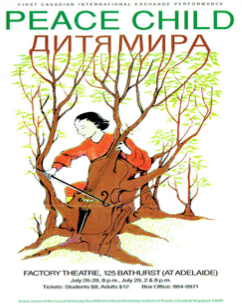
In her letter and the attached file of photographs and press clippings, you will get a sense of the story – and the excitement that the project generated in both cities. I have only one story to add which, to me, sums up the immense value of people-to-people connections and citizen diplomacy:
Quite early on in the rehearsal process in Volgograd, one of the Canadian girls fell sick and had to be rushed into hospital. The doctors quickly diagnosed acute appendicitis – and urged the tour leaders to authorise an immediate appendectomy. The tour leaders were terrified of what a mad communist might do to their precious Canadian child – but, as luck would have it, her father was a doctor, so the English-speaking Russian surgeon suggested: “Why don’t I talk to him?” Mercifully, they were able to get a call through to Toronto and find the father at his surgery in Toronto. The two doctors spoke for less than two minutes on the phone, then the Toronto father asked for the phone to be given to the Tour Leader: “Of course,” he said, “Go ahead with the operation. This man knows exactly what he’s talking about it – and I trust him completely. He sounds like a superb surgeon and my daughter is very lucky to have him to do the operation…” So – it went ahead. The girl was fine, and after a few days, was out of hospital and back on stage with the rest of the cast members. At a professional level – like medicine – politics is not even an issue. Doctors like them just get on with the job of healing people: why can’t politicians bring the same intelligence and professionalism to their jobs?
What is Peace Child For?
This is a question we agonize about even now – 40 years after we started the organisation! Very easy to quote our Mission Statement: “Empowering Young People” – but empowering them to do what? Since 2000, we have added the Gandhi aspiration: “Empowering Young People to Be the Change they want to see in the world…” I have often talked about “Empowering Young People to leave the world a better place than the one they were born into…” In the early days, it was all about ‘wanting to live’ – and delivering humanity from the scourge of war. Making Peace! (See Archived statements on ‘What we are about?’) But since we stopped doing the musical and started creating books and training programmes, Peace Child is much more about supporting and enabling young people to prepare themselves, and their peers, to live worthwhile lives – to espouse decent values, to care for each other – create jobs and livelihoods for each other. To me – this was the endless fascination of Peace Child: it was never a simple goal – looking after battered women, teaching children to read, protecting orphans. Peace Child always aspired to make the world a better place – and it’s slogans: “Youth-led Development” – “Building the Green Economy!” – “Harnessing the Arts in the Service of Peace” – “Empowering Young People” – point towards what may have been unrealistic aspirations, but aspirations that, none-the-less, are more important to youth than making war or making money.
Peace Child People
I’ve mentioned many who had an impact on Peace Child’s development – but there are so many others: Josie Jordan, Canon Kenyon Wright, Danaan Parry, Lucia, my father, Frank & Florence Weisfeld, Steve Riffkin, Stas Namin, Vlad Posner, Dharaj, Lib Segal, Bill Schintz – and the performers – Susannah York, Jessy Dixon, Marco, Melissa, Bridget… But there were so many wonderful, wonderful people who put their hearts and souls and money into this effort. Some I have photographs of (below) – but many I do not: people like Vicki Lewin, Sandi Croan. Some are famous – some not. All were inspirations and engines of Peace Child’s development – and there were thousands of them. Without them, ALL of them, none of this incredible story would ever have happened. So – THANK YOU!!
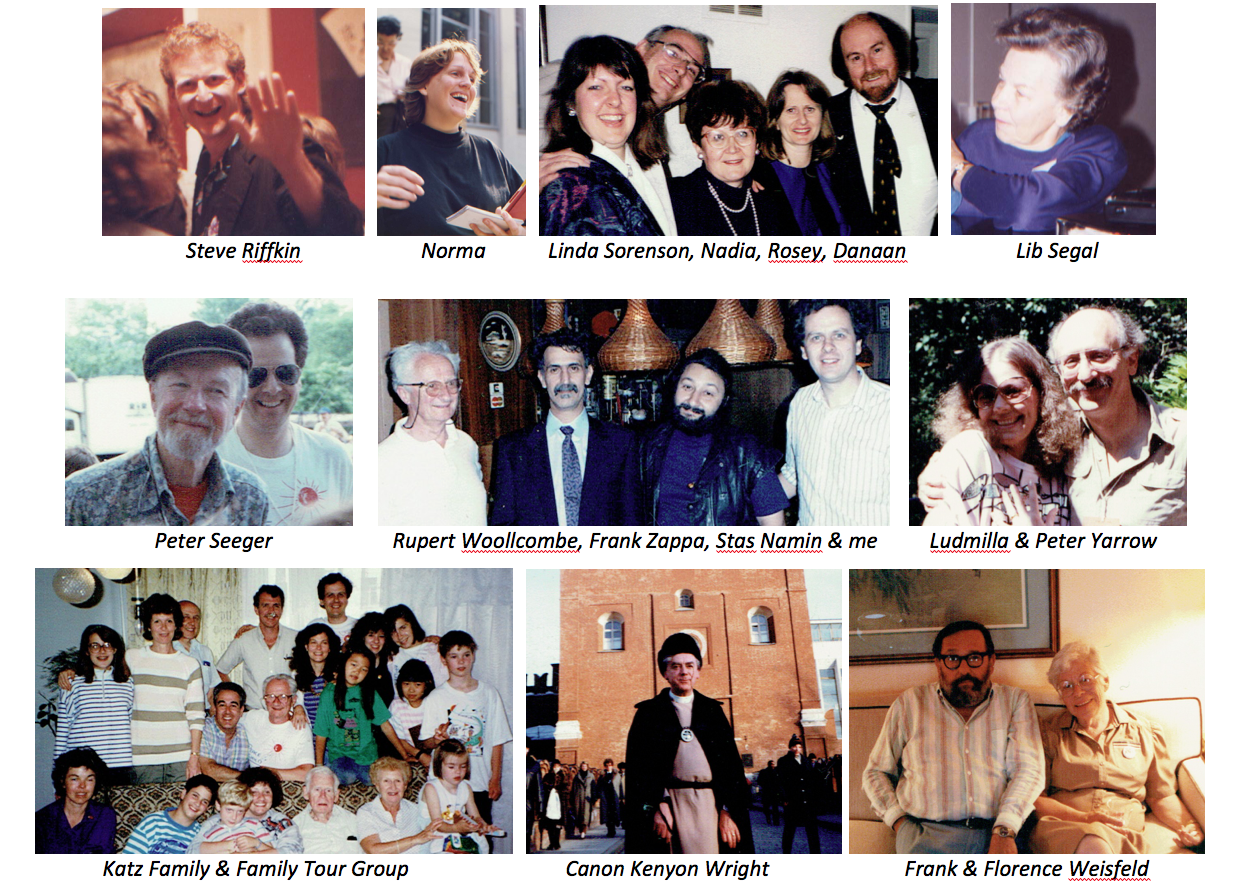
International Outreach
As word spread about Peace Child, we kept hearing of new shows happening in different parts of the world. Bendigo, Victoria, Australia – 100m north of Melbourne – was a hive of Peace Child activity,(Peace Child Australia Flyer) and a source of many wonderful Australians: Craig on the ’88 East Coast Tour – the Central America and East European tours, all benefited from their participation. We also heard tell of a German translation – done in Basel – and another in Mumbai about one set in Kashmir about the Indo-Pakistani conflict, but we never got the scripts. We did get the Belgian Programme – with all the songs translated into French (See here). And we do have some information on the Peace Child Argentina chapter and some material from the show in Wanganui, New Zealand. And – of course – we have some records and photos of Miki’s wonderful productions in Hiroshima, Japan.
A further development was the Family Tour. Several parents asked us why it was only their children who should have all the fun – going to Russia, meeting great Russian rock stars, going to concerts, plays, performances etc. We did several of them. My father, Rupert Woollcombe, suddenly realised that I was not being a total wastrel, doing this ‘Peace Stuff’ – instead of following him into his lawyer’s practice. Steve Riffkin’s parents, the Katz’s and the Matsers all came with their families to experience a taste of the Peace Child magic. It was the start of the tourist boom to the former Eastern Bloc….
Perhaps the most important international outreach was being done in Israel, where David Gordon had moved with his Israeli wife, Yael, and their daughter, Naomi. Peace Child Israel was the brainchild of a wonderful Israeli actress, Yael Drouyanoff, who saw in Peace Child an opportunity to bring together Israeli Arabs and Jews to workshop / improvise their fears about each other, and their different hopes for the future. With her relentless energy, she built Peace Child Israel into a robust component of the Israeli peace movement, which – in the 1980s and 1990s – was showing signs of making an impact. She died, tragically young, but Peace Child Israel lived on under the leadership of Melisse ??, until the prevailing attitudes, wall-building etc. starved it of funding and popular support.
City at Peace
At the same time as Peace Child was reaching out internationally, we were encouraged to reach in – and use the musical to solve some of the conflicts that were ever-present in our own, inner-city communities across the USA. City at Peace came about when a young, African-American girl from Rochester, New York told her Chapter president, “I now feel closer to my Russian friends, than I do to the white kids here in my own city…” Rosey was inspired by this – and put together a production team, led by Carlo Grossman, who, like Steve Riffkin, had emerged from the successful Kid’s Rights TV show. He, along with Rickey Payton and Rosey put together a cast of young people from the inner city and the Suburbs and toured the show to different schools and venues across the city.City @ Peace
It demonstrated, yet again, what a great leveller and peace platform the stage is: in deepest South-West Washington, a 14-year old mother of two from the projects sang and danced on stage with Rockefeller’s grand-daughter – and to this day, I don’t know which was which.
Katie Christie took the concept and developed her own show and theatre company, Voices United, around City at Peace in Miami. A brilliant documentary was made about her, and her show, which you can see here. After we left the USA, a City at Peace Foundation was set up and, for a time, promoted shows and workshops in many cities across America. In many ways, City at Peace was one of Peace Child’s most successful legacies.
Monkton Heathfield, UK International Show – 1990:
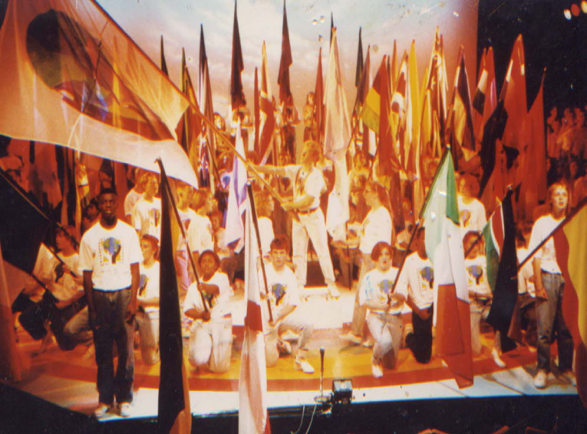
Steve & Helen Elliott’s 1990 international Peace Child production at the Monkton Heathfield School in the Summer of 1990 was one of the most prestigious, best-documented productions ever done. Performed first in Taunton, near the school, it was then taken to London where it was performed at the Shaw Theatre in the presence of Prince Edward, Jonathon Porritt and other celebrities.
The playbill with all its celebrity endorsements, the BBC documentary about the show, and the photographs – all testify to the immense power of the show, in particular, the extraordinary staging. It was visually magnificent, and the music, arranged by Julian Breeze, was also amazing.
It was a little unfortunate that the Shaw Theatre show fell on August 3rd – the day after Saddam Hussain invaded Kuwait, triggering the 1st Iraq war which was backed up by UN resolutions and thus, perhaps, a perfect example of a “just war”: the Taunton Peace Child show might have seen this coming – and made some script reference to it but it didn’t. As it was, the experience sat some what oddly in a Post-Cold War, pre-Mid East conflagration – in which the search for Peace was somewhat out-of-place. However, the whole initiative gave rise to the building of the Tacchi Morris Peace Theatre in the grounds of the Monkton Heathfield school which goes from strength to strength. Peace Child is most proud to have given an impetus to this incredible development.
View the BBC Documentary – here
View the Playbill & File – here
Ireland Tour
Many had asked us why we, as Brits, were so focussed on building peace between the USA and USSR – when a 700-year old battle had been tearing our people apart right on our own door-step in Northern Ireland. Fair point – but it took an American, Jennifer Reese, living in Cork to put together our first Ireland tour – which travelled an international cast from Cork through Dublin to Galway, Enniskillen and finally to Belfast. Ireland Tour Programme.The ebullient Frank Buckley trained the singers and led the band with a musicality that only the Irish seem to possess, and the tour was a happy continuation of the first Irish participation in Peace Child – when Kiera O’Sullivan from Kerry joined the East Coast Tour and sung a beautiful song in Gaeltacht as an unaccompanied solo.
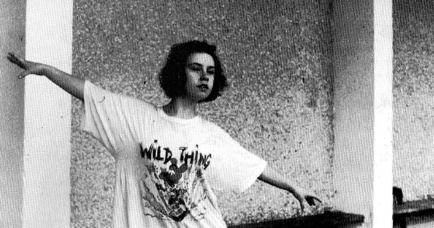
The 1992 Irish Tour was followed up by another International Programme that Rosey put together in Derry / Londonderry – with a grant from the European Commission’s Kaleidoscope programme. Pauline Ross(?) put together a beautiful version of the play and, though no causal link could be proved, it was interesting that these two productions came at a time when John Hume and David Trimble were, with John Major, putting together the first outlines of the plan which became the Good Friday agreement – just as our show had foretold. We’d had the experience by then of watching the US-Soviet Peace Child story come true with the fall of the Berlin Wall in November 1989. And no sooner had we done the Central American tour to Costa Rica and Nicaragua, the Escipoulas accords were signed by Oscar Arias and others bringing peace to that region. And Steve Riffkin led a tour to South Africa just months before Nelson Mandela walked free and the scandal of apartheid was finally buried in that country.
Was there a pattern here? We like to think so: if enough people believe in peace, the ‘100th Monkey syndrome’ takes hold and our inner feelings become our outer realities. I fear that the reverse may also be true: I write this memoir at a time that Donald Trump is trashing the Iran Peace Deal – Israel is bombing Iran, Russian bombs are flattening Syrian cities and Saudi Arabia is perpetrating a genocide in Yemen with British and other weaponry. Some protest – but very few. Millions marched for their lives, and for Black Lives Matter, across the United States – but even there, no one seems to be listening.
Peace Child, with its core values of caring, selflessness and integrity – stands for everything that many current politicians do not. Which is why it is time to re-invent Peace Child – and bring back that amazing spirit that smashed down the Iron Curtain – and liberated millions from the scourge – or at least the threat – of catastrophic war.
A Kremlin Interlude
As Glasnost took hold, and Mikhail Gorbachev was hailed as the “Man of the Century” – a huge reception was held at the Kremlin. The Kremlin leadership flew in icons of culture from all over the world. Norman Mailer and Yoko Ono came from the USA; a plane load of us were flown in – first class! I got to go because Natalia Sats invited me – as a representative of Children’s Theatre! I sat next to Graham Greene on the way home. Two other Peace Child founders, Michael and Eirwen Harbottle, were there for Generals for Peace, and Canon Kenyon Wright came representing Churches for Peace.

It was a stellar gathering, memorable for Gorbachev’s speech in which he told us the solution to all the world’s problems was: “More socialism….” Slightly ironic, given that two short years later, his socialist empire would fall to be replaced by a coterie of some of the most rapacious capitalists the world has ever seen. But – they brought prosperity and middle-class comforts to millions of Russians in a way that socialism was never able to.
Move to Europe
Rosey and I had never really planned the move to Europe. It happened because the wonderful Fred Matser invited us to come help start his Environmental Education Centre in the Netherlands: the “Milieubewurstsein.” Fred was a property developer who, at the age of 40, had moved into philanthropy, supporting people like Gerry Jampolsky and the World Game project. Bringing us to Holland was a difficult move for the family: for a start, it meant a new language, new schools, new home – and a detaching from the people and places who had given birth to Peace Child, and given us such wonderful support and friendship. Rosey had just started on City at Peace, and wanted to help it develop. But she agreed: our children might benefit from being closer to their grand-parents and their cousins + getting an experience of living in Europe.
It was doubly difficult because, a few weeks after we moved – shifting all our stuff in a succession of flights! – I went back to manage the UN Peace Day Concert in New York. The first house we had was, apparently, built on a place that the Nazis used to execute prisoners during the 2nd World War – and Rosey was spooked by the place, especially when the 1st Hurricane Europe had experienced for decades swept through the flat landscape.

Things got better when we moved to our home in the woods and started producing the Peace Child show in Arnhem, Die Brug. This was an unusual show in that, I think, it was the only time that we produced a story that had an unhappy ending: the Dutch children were not about to be persuaded that things would turn out well. Rosey felt it was a very depressing Peace Child. I thought it was very honest.
More surprising stories were to come in the Central European Tour: the Arnhem show had happened while the Berlin Wall was coming down. We had some East Germans in the show – and they were understandably disturbed by the disappearance of their country, the DDR. The Central European Tour happened as the war was getting going in former Yugoslavia: Slovenia had already detached itself – and Croatia was on the point of doing the same. Bosnia was descending into chaos and bloodshed – and the young people we gathered in a castle in Trakorscan, Eastern Slovenia – were more compelled to seek peace than most other youth we’d encountered on the Peace Child journey. In the Czech Republic, still Czechoslovakia, Carlo Grossman was even more surprised to find out that the object of the children’s fury was their teachers: the show ended with the offending teachers being captured in a net on stage – and being drawn up into the fly tower – and left dangling! I don’t think they used any of David Gordon’s music in that show – but it did deliver an abiding image of a child dressed in white, emerging from the chaos on stage – a pristine Peace Child. Fascinating!

In Hungary, they decided that the Peace Child story was similar to the famous Hungarian fairy tale: Csongor és Tünde written by Mihály Vörösmarty. So they adapted that – and worked it into a strange set that looked like a globe. All three productions were extraordinary and novel takes on the Peace Child story, and an immensely valuable, if strange, experience for we, the Brits and Americans, involved.
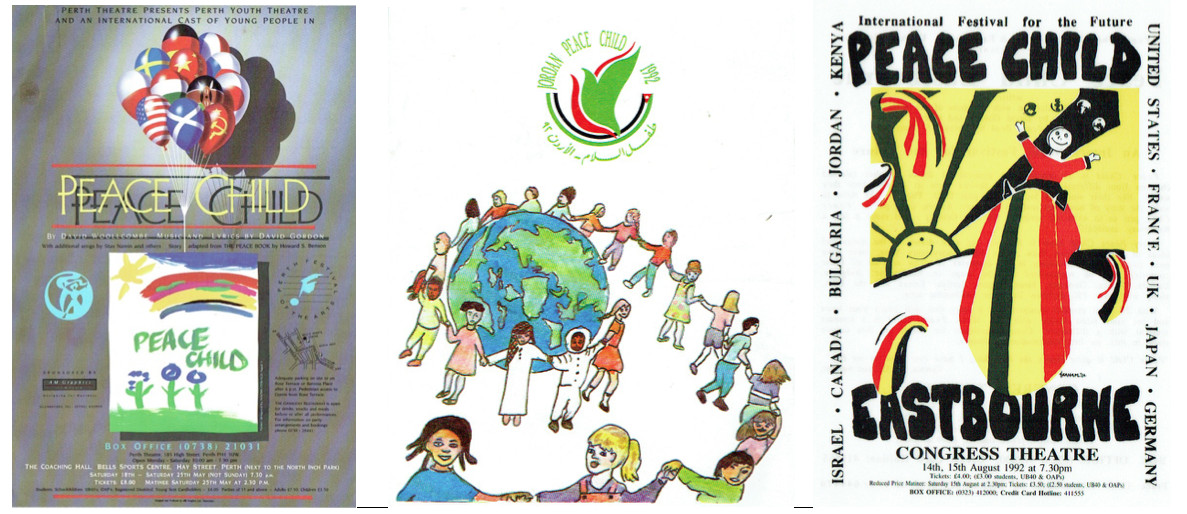
Perth and Jordan – and back to the UK: Eastbourne
In 1991, the Rev. Michael Hare Duke, inspired by my father, Rupert Woollcombe and a brief encounter with me, decided to produce Peace Child with the Scottish Churches in his home town of Perth. It, like the Monkton Heathfield production, was a joyous, international event – with some really good performances. I don’t remember much about it – except that the Duke of Argyll and Crown Prince of Jordan were there – and it was almost like a state occasion! I then had to drive back to London through the night – which was all rather exhausting. But it was a landmark Peace Child show – our Scottish Premiere – and it earned some good press. (Read More). It also led, directly, to an International Production in Amman, Jordan – produced by the Crown Princess. This was a spectacular affair – with massed bands of bagpipers, vast choruses, and Peace in the Heart with Arabic verses added. Young people from across the world flocked to the show – and, to Rosey’s eternal regret, only I went to see the show – travelling through Israel and across the Allenby Bridge to Amman (a journey that could take just half an hour but which, with the border check points, takes most of a day!) The Jordan show was another landmark event. It could have led to a whole new Peace Movement in the Middle East. But – by this time, I felt that the returns on Peace Child, the musical, were diminishing. And the priority of solving the Hot War between humanity and the environment were dominating my mind.
In 1992, we moved back to the UK. My parents had moved to Scotland, and wanted to sell their home near London – so we moved in and helped to sell it, while looking for a house to make the new Peace Child Headquarters. David Gordon had been doing great work with Peace Child Israel, and we’d just done the the show in Jordan – so we thought: where would be a safe place to bring together the young people from Jordan and Peace Child Israel. Where better than the sleepy British seaside town of Eastbourne – where we had long time Peace Activist, Howard Kensett, who had always dreamed of producing Peace Child in his home town, ever since seeing it at the Royal Albert Hall in 1981. Rosey and Eirwen arranged with Howard who – at the age of 92, had just got married for a second time to a lady 5 years older than him! His energy amazed us all – and the fact that the production happened at all was entirely down to him.
The tension between the Jordanians and the Israelis never entirely disappeared – but the show did move towards a resolution. And the vast cast and chorus made them feel very safe – and joyous as they looked towards a future at peace, with some elements of a 2-state solution – and the right of Jordanian Palestinians to return to their farms – which they could see, but never visit, across the Jordan river.
The White House and the Book Creation Business
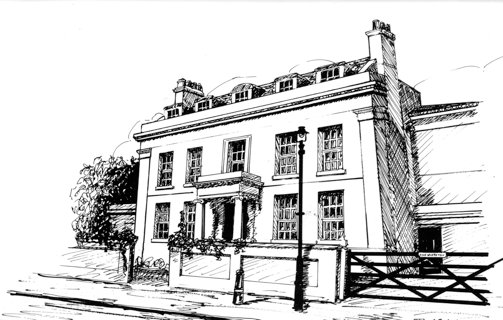
This website tells the History of the Peace Child Musical – so what happened in the Peace Child History outside of the musical is not really a part of this story. However – the other stuff provides the context for the developments in the musical, and shows how the organisation grew to what it is today. Central to that development were two things: first, the purchase of the White House (above) – and its transformation into the Peace Child International Centre. Students lived in the Stables, and worked in the basement, while Rosey and I occupied the top floor – which we transformed into a huge office.

The transformation of the Stables was, in itself, a wonderful example of Youth-led development: we’d had plans drawn up by a local architect to re-build them and the son of one of our Czech contacts had dropped by while on holiday in the UK. As he was training to be an architect, he asked to look at the plans: “Oh,” he said, “Young people wouldn’t like living here!” So – he set about re-drafting them – and then decided to learn the UK Planning procedures by working through the submission process with us. Permission granted, he returned to the Czech Republic where his professors wisely told him: “You can sit in our classes and you will learn something – but not nearly as much as if you go back to England and help build the building you have designed.” So – he came back, and created the Stables where young people from around the world lived happily, and created 30+ Peace Child books and education programmes over 23 years.

The second thing was the creation during the Central European Tour of our First Book – a project led by an incredible young Argentine American, Analia Penchaszadeh. Desk-top publishing was in its infancy – and this whole book was put together on Cardboard sheets. It invited schools and individual students to submit stories, paintings and poems + questions to find out “Everything you wanted to know about the Environment but were afraid to ask….” We then put those questions to a number of experts, taking young people with us, to ensure that they understood the Experts answers. The finished book, though short, is one of our best – and, when distributed to officers of UNEP, UNICEF, UNDP and UNESCO at the Rio Earth Summit – it won us the chance to make our second book. Rescue Mission : Planet Earth – which went on to sell over half a million copies and be translated into 23 languages. That set up PCI and its White House headquarters in the Book Creation business – which kept us busy for the next ten years – producing all the books which are archived here. Several Flyers and Brochures promoted the work of Peace Child at this time, See Here:
Uniting Europe Peace Child Games
On arriving in Europe, we had organised a meeting of all the European partner organisations we had encountered while working in the USA. Fred generously sponsored this meeting at a castle in Haarzuilens. At this meeting, we met Werner Greis and Miclos Banhidi – co-founders of United Games who were determined that the old barriers between East and West Europe could only be dissolved by having young people play games with each other. They became wonderful partners – and great friends to us, and Peace Child over the years – and are still! We also met there Kristin Eskeland whose “Voice of the Children” programme got us involved in the build-up to the Rio Earth Summit – and, later, in the Post-Pessimist movement in the former Yugoslavia. It was a landmark meeting – and you can read the Report here.
In 1995, for the 50th Anniversary of the United Nations, United Games decided to do simultaneous productions of the Peace Child musical in each of their six partner countries.

So, following multiple trips across Europe by Rosey and I to supervise productions, at 8.00pm on Saturday 10th June 1995, six casts took to the stage in Murzzuschlag, Austria; Berlin, Germany; Gyor, Hungary; Subotica, Yugoslavia; Olomouc, Czech Republic and Izola, Slovenia. Read More…
Peace Child Habitat – Istanbul
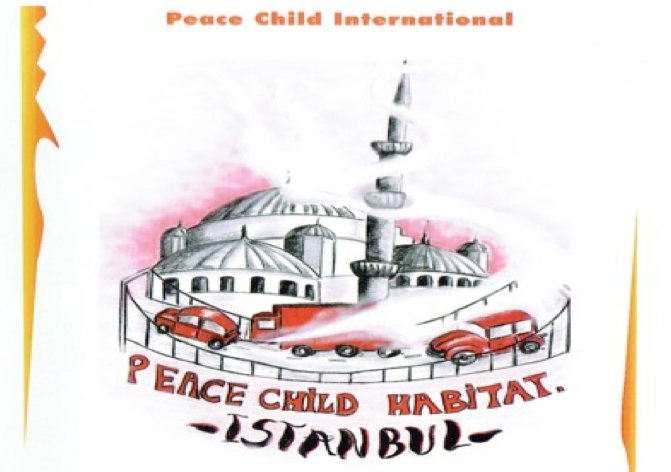
Again, I have no idea how we became involved in this – but I suspect it was some link I made doing the Rescue Mission book. We worked with UNEP which was headquartered in Nairobi – and UN Habitat worked in adjacent offices. So – as their 2nd Habitat Conference, scheduled to be held in Istanbul, had a strong youth focus (“HABITAT TWO – YOUTH CAN DO!”) – they agreed to sponsor an international Peace Child show as part of the cultural offering of the Conference. Rosey took the lead on this – flying out to Istanbul in January – waiting in a snow-storm for a music director who never arrived, and having to ease blood from Ottoman stones to make the whole thing happen. It was a wonderful international show – with the cast all staying in a boarding school near the Grand Bazaar – and doing the production in the Ataturk Centre on Taksim Square. Istanbul 1996 Programme
The cast were somewhat alarmed when they read that thousands of stray dogs and feral cats had been herded off the streets of the city and destroyed – so as not to give a bad impression to the diplomats visiting for the Summit Conference. This seemed to them very bad manners – so we included a scene in the show with several members of the cast dressed as cats and dogs, protesting that they had Habitat rights too. It was a fun and moving show – with a great delight for Rosey and I that it was the first Peace Child show that our daughter, Natasha, had taken part in. Our son, Alexander, had taken part of many Peace Child shows – to the point where he once said, plaintively: “When Peace breaks out, can we stop doing Peace Child?”
The Hague Appeal for Peace Show – 1999:
Each of these paragraphs compresses months of activity, tons of letters and e-mails, countless phone calls and faxes, and legions of dedicated people – all of whom, magically, came together to produce these extraordinary shows. Nowhere was this more true than of the Hague Appeal for Peace show – written after the landmark Rio Earth Summit of 1992 – which had been through several iterations, “The Bridge” / “The Eastbourne Show” / “Greenpeace Child” and “Peace Child 2000.” It was this final one that a Dutch School in the Hague agreed to produce, in English, for the enormous Hague Appeal for Peace meeting – designed to celebrate the centenary of the meeting convened in 1899 by Tsar Nicholas II and hosted by the young Dutch Queen, Wilhelmina. The commitments to disarmament expressed at this conference were astounding – and unreal, given the speed and intensity of Germany’s re-armament programme. But the conference did result in the International Court of Justice – or Peace Palace – which is why PCI agreed with Cora Weiss, that the centenary was well worth celebrating.

We secured Peter Ustinov to play the part of the Story-teller – which was good. He could only do one of the performances, so for the second, the school recruited a Dutch comedian who, in many ways, was a more sympathetic story-teller than Ustinov who never appeared happy performing with children or animals! Also – the practice of bringing in a Story-teller at the last minute to narrate the show is not one we would recommend: every cast builds up its own dynamic – and having such a significant role be played by some one who only turns up an hour or so before show-time is never ideal. It didn’t work with Ustinov who, I fear, did not enjoy the experience.
See Playbill.
The Children’s Earth Summit and World Youth Congress Business
1999 was a busy year for many reasons. First, there was the Hague show (above) – then we were finishing off our most expensive book, Pachamama, for the UN Environment Programme – funded by the Ted Turner Foundation from whom we’d asked for $100,000 – but who, for some reason, had given us $250,000. Most significantly, we were preparing for the Millennium Young People’s Congress (MYPC): on the eve of the Millennium, we were canvassing the young people of the world for their Millennial Priorities – what were the ten most important issues that they wanted the UN, and their governments, to address in the new Millennium. We reached millions of young people in what became our biggest outreach effort ever: the buy-in was extraordinary, from the King of Morocco, to WWF in India canvassing the views of 5 million young people. Having had such a success with Rescue Mission, we were well-placed to reach out to UN networks in almost every country on earth. And the fact that the Congress was being held in Hawaii made it a very attractive prospect for young people everywhere.
And we had fantastic young people working on it everywhere – including Alexander, who – almost single-handedly – held together the administration in Honolulu. (“The worst job I’ve ever done! I’ve never worked so hard in my life – or been so frustrated! I’m never working for my Dad again!”) Marina Hermann, in Argentina, was only 19 – but she assembled a delegation of 40 from her country who were always the noisiest group in the canteen.
The Top Priority turned out to be: “Education” – but not education as we know it: Education about the priorities that we will face in our lives in the new millennium: environmental education, education for entrepreneurship, education for peace, population control, sustainable behaviours etc. It was a magical Congress – and so much enjoyed by everyone there, we went on to do five more – in Morocco, Scotland, Canada, Turkey and Brazil. The inspiration for it was that the Rio Agenda 21 process – in which we had invested so much with our Rescue Mission Indicators Project (Link 41), our School Agenda 21, our Ambassador programmes (Link 43) and so much else, was being wound down by governments.
They had moved on to the next thing. Which – in this case – turned out to be the Millennium Development Goals(MDGs). Interestingly, the UN’s 8 MDGs turned out to be pretty much the same as the top ten priorities selected by our MYPC the year before, leading Noel Brown of UNEP to tell our delegates at a meeting in New York to launch the Congress Book, Be the Change, “Your priorities are our priorities. We must work together to see them realised….” The two MYPC priorities which UN Member governments left out were: combatting government corruption & protecting everyone’s Human Rights.

The most important outcome of that First Congress was the concept of “Youth Led Development” – the idea that young people could actually deliver effective development aid – NOT just be the beneficiaries, or targets, of it. More broadly, as one said: “We do not want to be passive bystanders watching as our world decays and dies before our eyes: we want to DO something!” This idea became encapsulated in the book I wrote about it for the Schumacher Society some years later. (Link 44)
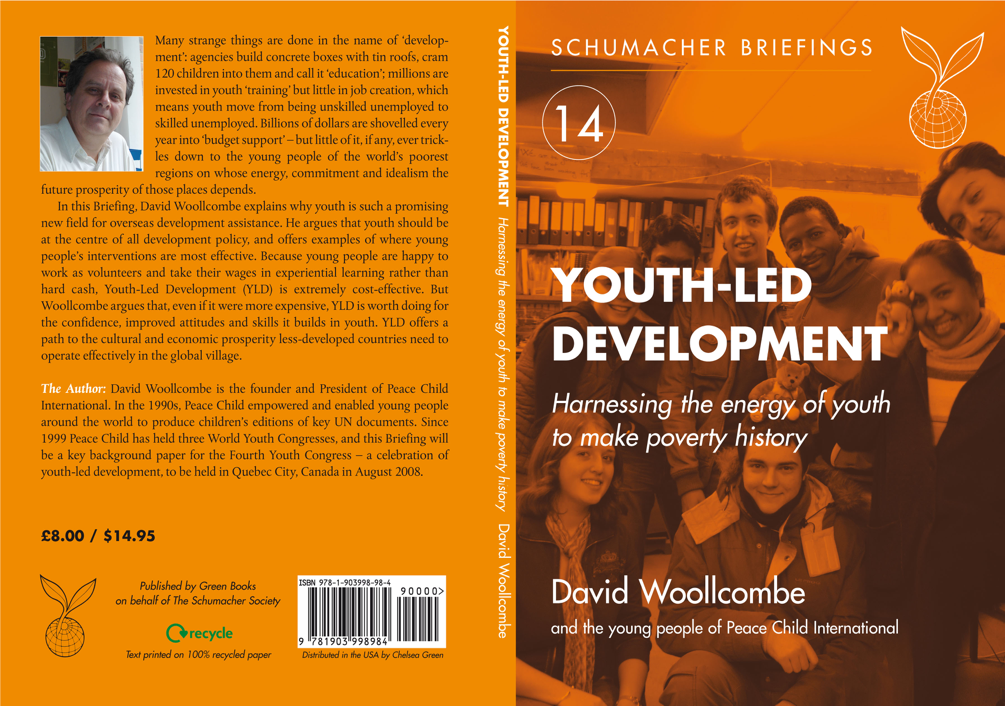
It also gave rise to a new Peace Child slogan: “First Inform yourself; then take ACTION!”. That gave rise to a whole raft of Peace Child Action Projects, most in Low Income Countries – where young people created and managed their own projects. We made a video about some of them in Sierra Leone, and created Be The Change Academies to teach young people how to make livelihoods in this way.
Educating for Sustainable Behaviours
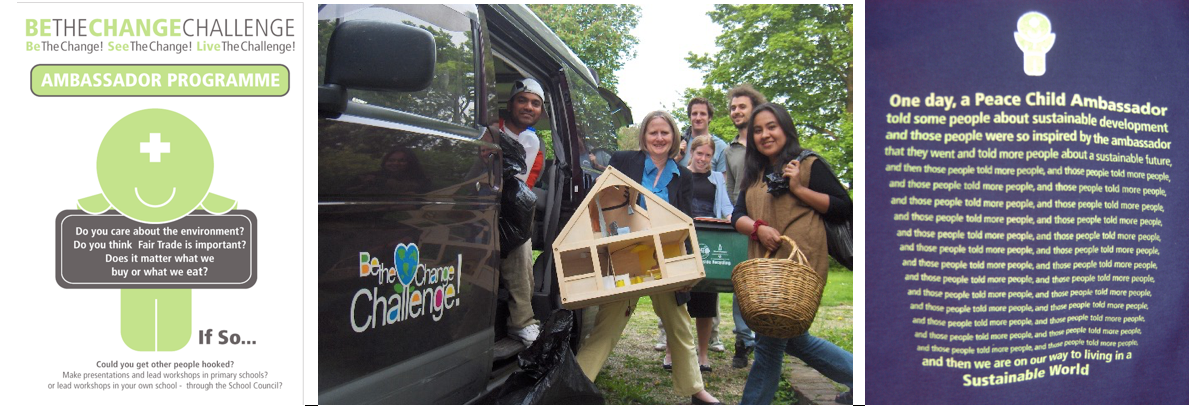
Rosey managed to get a grant from DEFRA (the UK Environment Agency) to promote education for sustainable behaviours in schools using youth as ‘Ambassadors’ to train their peers and empower them to live sustainable lifestyles. The interesting element of this story was that DEFRA required the project to show evidence of Behaviour Change, not just that the kids understood what it meant – or how to do it. For that, Rosey, along with kids from local schools, developed Lifestyle Contracts and a ‘Day in the Life’ video. There was a secondary school, and a primary school version of the Contract – and Rosey, and her brilliant mentor, ?? – were able to prove the sustainable nature of the young people’s behaviour change in their different reports. Result? – Rosey had the grant renewed 3 times, and then taken over by the Paul Hamlyn Foundation for two further grants. Her effort kept Peace Child alive, the White House humming, and the movement towards sustainable lifestyles embedding itself in the British psyche.
Peace Child / Alpha Omega Show – 2009:
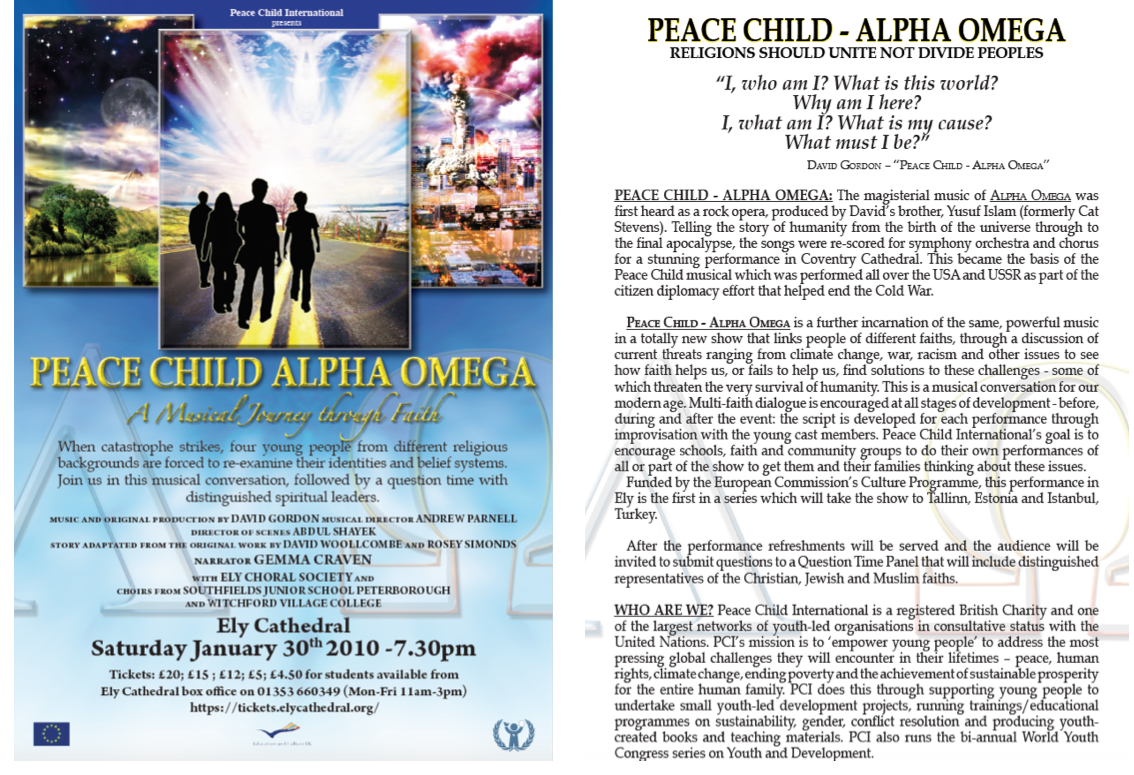
The Peace Child / Alpha Omega show described above is still available for performance by school orchestras, choirs and community groups. Unlike any other Peace Child show, this one deals with inter-religious mis-understanding – and, through a child’s eyes, sees ways to find a deeper harmony. As the Jewish Rabbi who spoke at our post-show discussion, said: “Every time I encounter a passionate believer from another faith tradition, I find my own belief enriched and strengthened.” That is the purpose of Peace Child / Alpha Omega – and we urge schools and communities to dive in and make their own version of this challenging and fascinating show.
1. Script (Link 45)
2. Choral Score (Link 46)
3. Orchestral Score (Link 47)
4. Lesson Plans (Link 48)
5. Production Notes (Link 49)
6. Video – Show (Link to VIDEO 12)
7. Video – Discussion afterwards (Link to VIDEO 13)
The Geneva Show – 2013:
It was always a bit of an unknown about Peace Child – how much Mikhail Gorbachev knew about the musical – and whether or not he raised it in his meetings with Ronald Reagan. Some say he did – others keep silent. But – when it came to the 20th Anniversary of his Green Cross organisation, it was he who approved the decision to do a new version of the musical that addressed the issue of Climate Change. It is this version of the musical which is currently being promoted as the new High School version of the musical – and it tells a very contemporary story of what needs to happen to avert the biggest existential crisis facing the human family on the planet: the threat of massive climate disruption.
With the support of the Green Cross Organisation and their contacts at the UN, we were able to set up a ‘one night only’ show in the Grande Salle of the UN Building in Geneva. We had hoped to rehearse at the Caux religious retreat centre above Montreux – but, when they failed to respond to our multiple enquiries, we decided to lodge the international cast members with local Geneva families and rehearse at a Stage School just outside Geneva. It worked really well.
Richard Sharpey. David Gordon’s long-time collaborator and arranger took on the role of MD – and a wonderful Devon-based choreographer, Claire Parker, created amazing dances and injected massive energy into the Show. Rosey was the story-teller – and I wrote and directed.
The show was something of a triumph. It was the first time since the end of the Cold War that I’d felt that Peace Child actually still had relevance to the hopes and dreams of young people facing an uncertain future. We were lucky to have a spectacular cast of extremely talented young people from all over the world: USA, Ireland, UK, China, Indonesia, Ghana, Argentina – everywhere! And the greatest compliment: the audience – mainly staffers at the UN – standing in applause at the end, willing the young people to do what they had been unable to do: unite nations in pursuit of the common good.
− You can see the whole show on video – here (Link to VIDEO 14)
− View the flyer – here
− View the playbill – here
− View the Script and Score – here (Link 51)
− Study the Lesson Plans & Production Guide – here (Link 52)
ENOUGH OF THIS HISTORY
– it is time for YOU to starting making your own HISTORY –
We just got a video of a wonderful international show done by our friend, Stacey McEnnan, in Los Angeles. Same songs, same energy – different story. (Link to VIDEO 15) As relevant now as it was back in the 1980s. And the children who did reported exactly the same impacts. I did a new version for primary school kids – which I was fortunate to produce at the local Middle School here in Buntingford: it concerns kids making peace in Yemen – which is a current concern. (Link 53) The point is – you can use the Peace Child musical to explore, and resolve, almost any issue in the minds of young people. And, though it is hard work, it is the best fun, most impactive, most memorable way of learning about the most important challenges that our children will face growing up in this turbulent century. Go do it!

